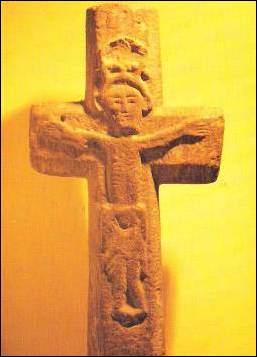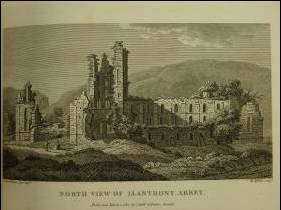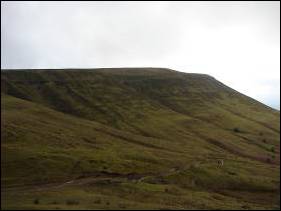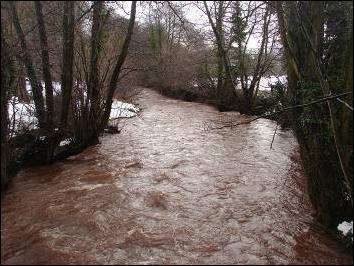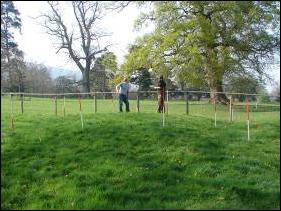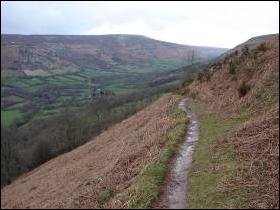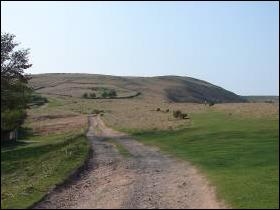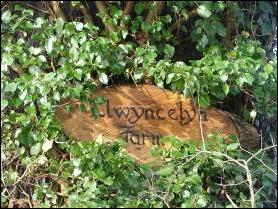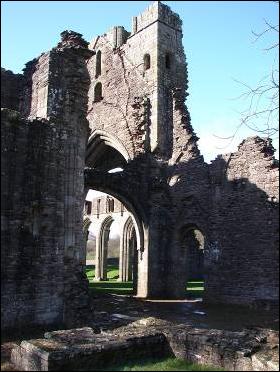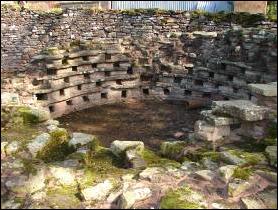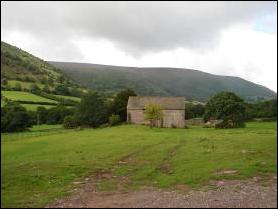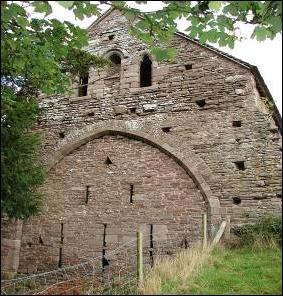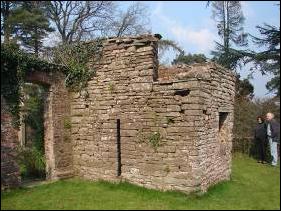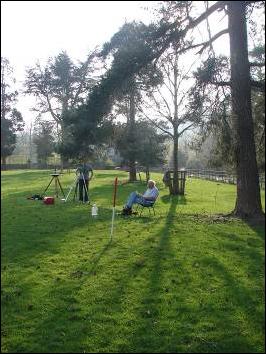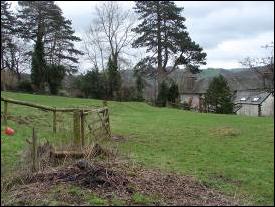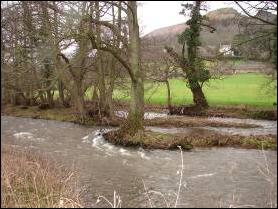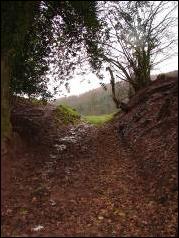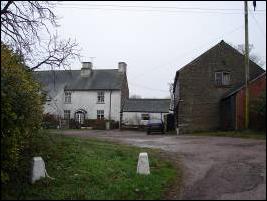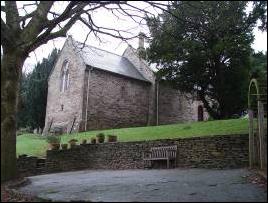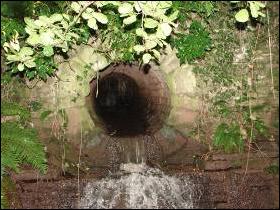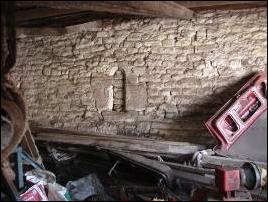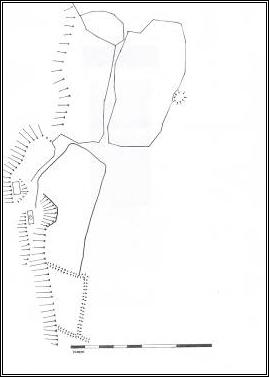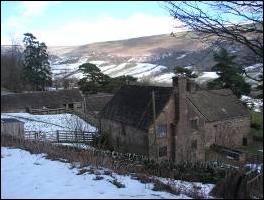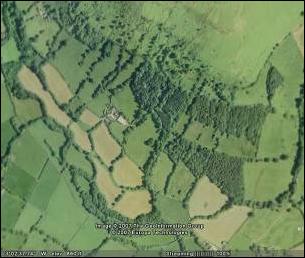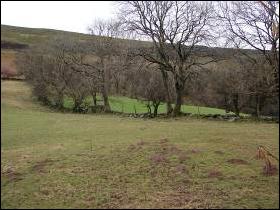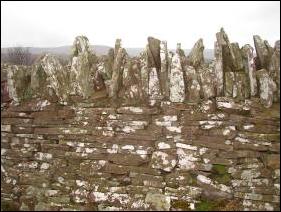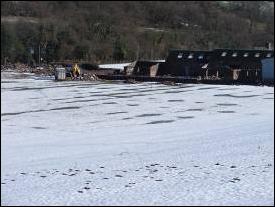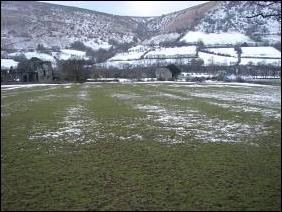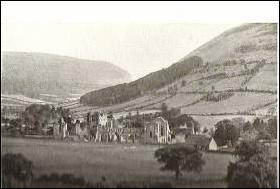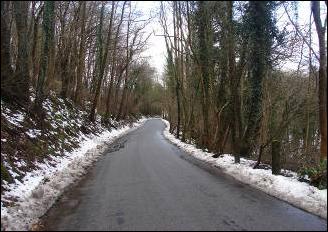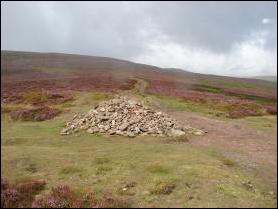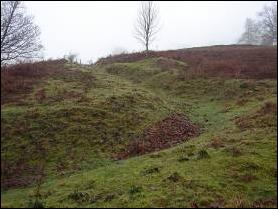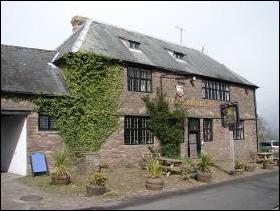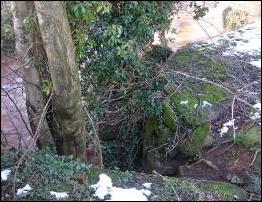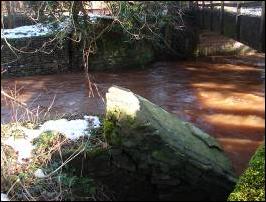Title: | Llanthony Priory in the Vale of Ewyas: The Landscape Impact of a Medieval Priory in the Welsh Marches |
Date: | 2007 |
Guest Contribution: Introduction
This dissertation, outlining the history and landscape impact of Llanthony Priory, has been written by Eddie Procter and is reproduced here in full with the author’s kind permission.
Ewyas Lacy Study Group

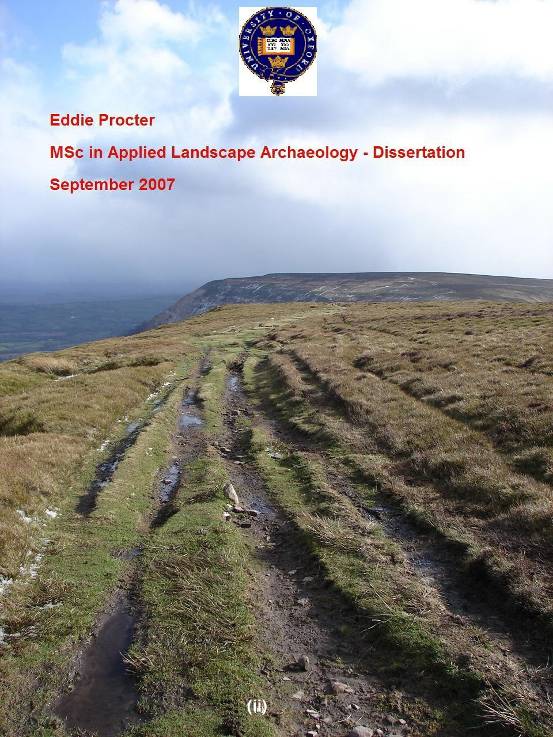
| Contents |
MSc in Applied Landscape Archaeology
Dissertation
|
Acknowledgements
1. Introduction
2. The geography of the study area
3. Research questions
4. Research methodologies
5. The development of the Priory, its estates and holdings
6. Evidence of monastic landscape features in the study area: a topographical survey
7. Conclusions and recommendations for further research
List of maps and plans used for reference
|
page 5
page 15
page 19 page 27
page 48
[Follow link to view] |
(iii)
|
Appendix 1: Appendix 2:
Appendix 4:
Appendix 5:
Appendix 6:
S11:
SI2:
|
[Follow link to view] Satellite Image of the study area Ordnance Survey Old Series one-inch map of the study area (1832) Plan of Llanthony Priory precinct and enclosure
Checklist of monastic landscape features in the study area
List of settlement, farmstead and landscape feature names in the study area Potential sites for further survey in the study area
[Follow link to view] Documentary records of Llanthony Priory estates and holdings
|
(iv)
| Acknowledgements |
|
Figure 1: Thirteenth century cross in St Martin’s Church, Cwmyoy; thought to be a wayside cross on the pilgrim’s way to St David’s. | Lisa Balmforth is thanked for proof reading the dissertation and suggesting improvements. Grateful thanks go to James Bond for providing expert advice on monastic landscapes and accompanying the author on an interpretive visit to the study area.
Valentine Walsh and Bob Child are especially thanked for permission to carry out the earthwork survey in their field at Tre-wyn, allowing me to photograph their copy of the 1726 estate map and generously permitting access to the grounds of their magnificent home, Tre-wyn House.
|
I am particularly indebted to fellow MSc students Chris Green, Geoff Morley and Ben Morton who generously gave their time and provided considerable assistance and interpretive input during the weekend of earthwork survey. The Severn Partnership are thanked for providing the Total Station for the survey.
The staff of the Glamorgan and Gwent Archaeological Trust SMR, Clwydd and Powys Archaeological Trust SMR, Welsh National Monuments Record, Welsh National Library and Gwent Records Office are thanked for the help they provided with accessing tithe maps, aerial photographs, other records and information for the study area.
Tim Hoverd, Archaeology Projects Officer at Herefordshire Archaeology, is also thanked for supplying, maps, plans and information on the potential grange site in the upper Olchon valley.
| 1. Introduction |
| “Precipitous rocks…encircle the dark valley and are crowned by airy woods. The intervening valley on the other hand, bristling with trees of many sorts, thickly set, sinks to the narrow depth of a dark abyss, yet is exposed to the inclemency of all weathers…” (Contemporary twelfth century account of the position of Llanthony Priory by its anonymous chronicler, quoted in Mee, 1951). | ||
|
|
|
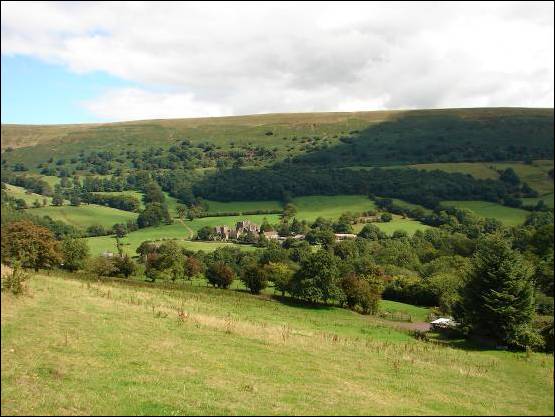
Figure 2: Llanthony Priory in its landscape setting, view looking NE from the W side of the valley (Author’s photograph, 26th August 2006).
Any visitor to the Augustinian Priory of Llanthony in the Vale of Ewyas cannot fail to be beguiled by the ruins themselves and their peaceful and remote location in a backwater valley of the Black Mountains in the Welsh borderlands (see figure 2). Those with an interest in landscape archaeology and history may also begin to wonder about the impact and influence the foundation and economic activity of this monastic house had on the surrounding landscape. This is the central theme of this study.
In addressing this impact there is a need to step back from the Priory precinct and consider the wider landscape and what elements have been formed, shaped or influenced by monastic activity (Greene, 1992). This is a subject area that has been surprisingly neglected. As Bond (2004, p10) has pointed out, “despite a vast literature on monasticism, relatively few monastic estates have yet been subjected to topographical examination”. Aston (2000) has also stated that detailed research on the topography of individual estates is needed to build up the body of knowledge on how monastic houses developed in their landscapes. In his report on the excavations and investigation of the Priory site commissioned by the Welsh Office in 1978, Evans (1984, p52) recognised that the wider impact of the Priory had not been investigated: “Whilst much has been written on Llanthony, most of this has tended to concentrate on architectural aspects of the Priory, or on its constitutional history, rather than to examine wider issues, such as the nature of its economy, the management of its estates or its impact on the surrounding landscape” . This study therefore attempts to take up this challenge and begin to address some of these issues.
This is a potentially large and complex area of investigation and there are therefore some important boundaries that need to be drawn to identify what is and is not covered by the study. The temporal focus here is on medieval landscape features associated with the economy and activity of the Priory and its estates. Although the Priory complex forms a central element or agent, this study does not set out to provide a comprehensive standing building or architectural archaeology of the ruins of the Priory themselves - this work has already been carried out (Evans, 1980, 1984; Gardiner, 1916). Nor is it only concerned with the immediate infrastructure surrounding the Priory, although this is an important part of the overall picture. The focus will be wider to encompass the geographically and administratively defined Vale of Ewyas in which the Priory stands and including the small outlying but closely linked parish of Oldcastle (see figure 5). A number of sites and landscape features in the wider surrounding area related to the Priory, through ownership or other connections, are addressed where this is deemed useful in creating a picture of the monastic landscape. It has to be stressed that this analysis is preliminary and hopefully provides a starting point for further work.
|
|
Figure 3: Set of engravings of the ruins of Llanthony Priory by Sir Richard Colt Hoare (After Coxe, 1801). |
It is prudent to have a robust and critical perception of what monastic landscape actually means. It could be argued that a monastic landscape is simply the landscape of organised manorial units, irrespective of their ownership – monastic communities were wholehearted agriculturalists and operated in a commercial environment in much the same way as their secular neighbours, partners and competitors. However, certain key landscape elements associated with a monastic house can be articulated (some of which are also common to a non-monastic manorial countryside) and it is these that this study focuses on.
The specific research questions that the study seeks to address are outlined in section 3. The mix of research methodologies that have been employed to carry out the study are then described in section 4. Sections 5 and 6 form the bulk of the report and provide an account and analysis of the landscape evidence. Contextual information on the geography of the study area and the historic and archaeological background for Llanthony Priory are provided in sections 2 and 5 respectively.
Finally, the report is unashamedly visual, as any account of a landscape has to be. A large number of Geographical Information System (GIS) maps, scans of maps, plans, illustrations and, most importantly, photographs have been used throughout to illustrate the points made and evidence presented.
| Note on spelling and language Spellings of place and feature names in the study area vary across different historic documents, plans and maps and, in some cases, names vary between the English and Welsh language. The modern spelling and linguistic type, as found on the latest Ordnance Survey map series, is used throughout the text, with reference to older variations where appropriate. Appendix 5 provides variations and English and Welsh meanings for a comprehensive list of place and feature names covering the whole study area. |
| 2. The geography of the study area |
| “In the deep vale of Ewias, which is shut on all sides by a circle of lofty mountains and which is no more than three arrow-shots in width...” (Gerald of Wales (Giraldus), The Journey Through Wales, 1188) |
| 2.1 Orientation |

Figure 4: The Vale of Ewyas in its geographical setting (Source Google Earth)
Llanthony Priory occupies a remote spot in the middle of the Vale of Ewyas[1] , the eastern-most valley on the Welsh side of the Black Mountains in the Welsh Marches (see figure 4). The nearest settlements of any size are Abergavenny (9 miles to the south), Hereford (20 miles to the north east) and Hay-on-Wye (10 miles to the north).
The study area boundary (see figure 5) mainly follows the valley watershed[2] , with the exception of the south-eastern corner which takes in the parish of Oldcastle in the Monnow valley, administratively part of Wales and historically linked to the Priory, and in the southwest and south where it takes a more arbitrary line as the morphology of the valley becomes less distinct.
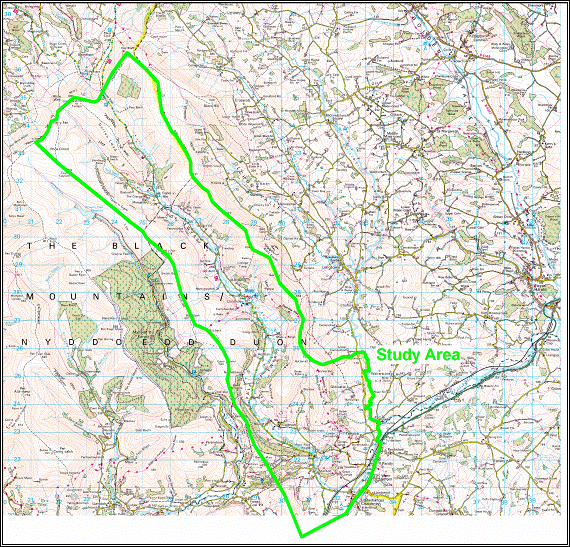
Figure 5: The boundary of the study area (Map created in MapInfo with Ordnance Survey 1:50,000 base map).

Figure 6: Looking N along the E ridge of the Vale of Ewyas forming the English-Welsh border, with the upper Monnow Valley in Herefordshire to the right (Author’s photograph, July 2002).
The Vale of Ewyas occupies a north-eastern spur of the historic county of Monmouthshire and modern-day Gwent/ Monmouthshire[3] (see figure 7) and borders help define its character and history. The administrative boundaries that divide the upper reaches from the main part of the valley and run along the east and west watersheds are of long-standing antiquity (see figure 6) and the area is squarely in the borderland of the Welsh Marches[4] . Monmouthshire has historically fluctuated between being part of England and Wales. The area consequently has a mixed cultural and linguistic history that influences its character today. As Morris (1998, p377) states in relation to the troubled history of the Welsh Marches, “Nowhere can you feel this ancient malaise more naggingly than in the Black Mountains, where the Welsh areas of Gwent and Powys meet the English county of Hereford, and where even in modern times certain tracts of country have been tossed back and forth between Wales and England. It is magnificent country, but baleful.”
|
| Figure 7: Part of Saxton’s 1637 map of Monmouthshire, with the study area to the right of the crest. |
| 2.2 Geology, geomorphology and hydrology |
| “The traveller…views the grand extent of the Monmouthshire wilds, and traces the different combinations of its majestic hills, which in some parts range into the most sinuous forms, in others extend for many miles into direct longitudinal ridges…” (Barber, 1807) |
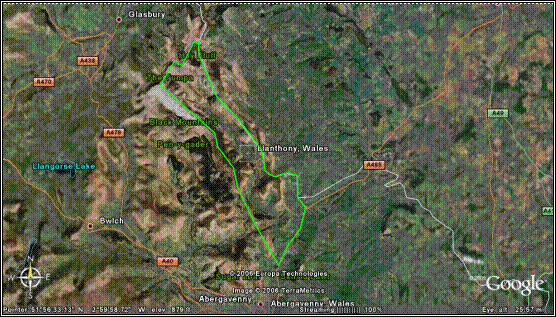
Figure 8: The Black Mountains, with the study area boundary marked in green (Map created in MapInfo with satellite image from Google Earth ).
|
Figure 9: The northern scarp slope of the Black Mountains. The Gospel Pass, leading into the Vale of Ewyas, is to the left of this photograph (Author’s photograph, 24th February 2007). | The position of the Vale of Ewyas, at the boundary between the fertile lower lying Herefordshire plain to the east and the Black Mountains and Brecon Beacon uplands to the west, is well represented by the satellite image in figure 8. The Black Mountains are formed by a uniform block of Old Red Sandstone, a belt of sedimentary rock built up during the Devonian period (Thomas, 2002) (see figure 10). Within the |
context of this geological uniformity are found: red marls on the more fertile valley floors and lower slopes as they broaden out and join the Vale of Usk and Monnow valley; hard, resistant brownstones forming the steep northern scarp slopes (see figure 9); lying above them the plateau beds, which give the uplands sloping gently from north to south their distinctive flat, table-top appearance; and outcrops of sandstones and conglomerates (Neville-George, 1970; Smith, 2003; Trueman, 1971). The soils are predominantly brown or reddish loam (Hassall, 1812; Rippon, 2004).

 Old Red Sandstone (Senni formation)
Old Red Sandstone (Senni formation)  St Maughan’s formation
St Maughan’s formation  Brownstones
Brownstones
Figure 10: 1:50,000 map of the solid geology of the region (From Digimap)
The Vale of Ewyas[5] is one of a series of parallel northwest to southeast orientated valleys that dissect the upland massif and give it its strong ridge and valley pattern (www.naturalengland.org.uk) . The upland ridges are in many places at an altitude of over 600m, reaching over 800m at the highest points. U-shaped in character due to the effects of glaciation during the Ice Age, the valleys are drained by tributaries of the Usk and Monnow rivers, whose waters feed eventually into the Bristol Channel. The River Honddu (see figure 11) flows through the valley, flanked by the Hatterrall ridge to the east and the Ffwyddog ridge to the west. As the river enters the lower part of the valley, its course diverts sharply eastwards to join the Monnow. The original course southwards to join the Usk, is blocked by a large moraine deposit formed as the ice retreated at the end of the last Ice Age (Thomas, 2002).
|
Figure 11 above : River Honddu in full spate (Author’s photograph, 11th February 2007). |
|
Figure 12 opposite : Typical gully stream in the valley (Author’s photograph, 31st July 2005).
The Honddu and its main tributary, Nant Bwch, are fed by large numbers of fast flowing streams running down the steep valley sides, often from springs on the upper slopes, which have fluted the valley sides with rilling and gullying (see figure 12). The steep-sided nature of the upper slopes are emphasised by extensive outcrops of crags in the northern part of the valley and also above Cwmyoy in the south. The more gently sloping lower slopes and valley floor are characterised by hill-wash and colluvial deposits.
| 2.3 Overview of present-day landscape character |
| “Mongst Hatterill’s lofty hills, that with the clouds are crown’d, The valley Ewias lies, immur’d so deep and round.” (Michael Drayton, Polyolbion, 1622) |
The topographical and land-use character of the study area (see figures 13 and 14 and the satellite image in Appendix 1) places it firmly in the belt of ancient or bockage countryside that dominates the landscapes of Wales, western and northern England (Emery, 1989; Hooke, 2006; Rackham, 1986). The geology and geomorphology of the area also give it a strong upland flavour and the exposed ridges on either side of the valley are dominated by extensive open heather moorland and wild grasses, grazed by sheep and pony herds and managed for grouse shooting in the modern period. The birch and hawthorn scrub and bracken of the upper slopes gives way to a mixture of semi-natural broadleaved woodland, early twentieth century coniferous plantation and rough upland pasture (significant amounts of which are being reclaimed by bracken, scrub and tree cover).
The area of cultivated land is a narrow strip for most of the length of the valley, generally less than half a mile wide, and only broadens out in the lower reaches as the upland ridges taper out. Pasture and meadow for sheep, cattle and horses predominate and there is only a small proportion of land under arable cultivation. The dominant field morphology is irregular small to medium-sized fields with mature, over-grown and often tree-lined hedges. Stone wall or earth bank field boundaries characterise the upper part of the valley and the rough grazing on the higher slopes. Larger and more regular shaped fields, subject to a higher degree of agricultural improvement, characterise the more fertile lower lying and southern stretches of the valley. For much of its length narrow belts of mixed semi-natural broadleaved woodland border the Honddu.
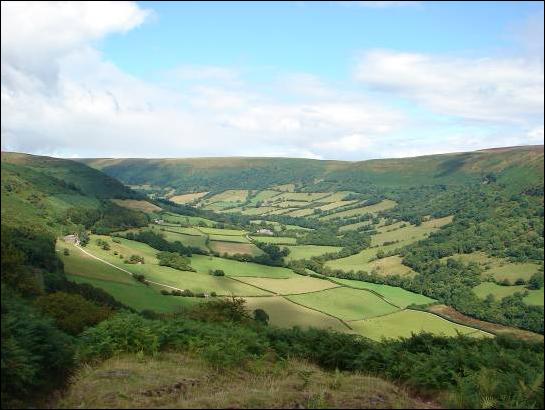

Figures 13 and 14: Vale of Ewyas, looking N in summer and winter. An upland valley landscape of moorland, scrub, woodland, a mixture of small irregular and larger regular field patterns and isolated farmsteads (Author’s photographs, 26th August 2006 and 11th February 2007).
The valley is quite thickly spread with scattered or loosely clustered farmsteads along the slopes of the valley sides (some now ruined, many renovated for domestic non-agricultural use), becoming less frequent in the wilder, higher and less fertile upper reaches and with larger farm units at a lower density as the mouth of the valley broadens out. The area is and has historically been sparsely populated[6] and contains only a few hamlets and the small village of Llanvihangel Crucorney on the main A4137 road between Abergavenny and Hereford that forms the gateway to the valley. Many of the vernacular farm buildings in the area date from the eighteenth and nineteenth centuries, with some from the early post-medieval period and many likely to occupy sites of long-standing occupation. The upland ridges have been subject to extensive quarrying for building stone for local walls and buildings and also localised peat cutting but show no evidence of other industrial activity.
The valley is served by one minor road running along its course, often following the Honddu, from Llanvihangel Crucorney to Hay-on-Wye by way of the Gospel Pass over the northern scarp slope of the Black Mountains massif at Hay Bluff. A network of small lanes, trackways, bridleways and footpaths criss-cross the valley radiating out from and connecting settlements and farmsteads.
| 3. Research Questions |
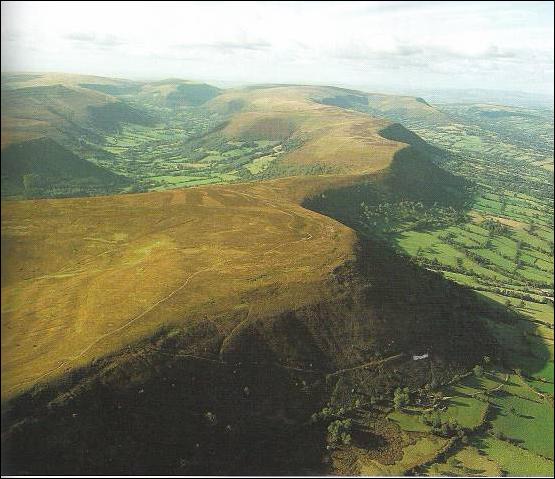
Figure 15: Llanthony Priory (visible in the Vale of Ewyas, top left) in its upland and border setting. The ridge along the centre of the picture forms the Anglo-Welsh border (After Hooke, 2006).
This study is an assessment of the impact and influence the foundation and operation of Llanthony Priory had on the surrounding landscape. Did the landscape simply develop the same patterns as the surrounding upland Welsh agricultural areas or did the Priory leave more of a mark than the dramatic ruins and immediate associated features that have so far been studied? What are the origins and dynamics of the mixed moorland, agricultural and woodland landscape that has developed here? When and how did the present pattern of fields and farmsteads develop? What part does the border location of the study area between upland and lowland and in the volatile and fluid Welsh Marches play on its landscape development (see figure 15)?
It is not fully within the scope of this study to answer all of these general questions around the wider themes of how monastic and upland landscapes developed in the medieval period. However, they do underpin the more specific areas of research that are outlined below.
|
Figure 16: Boundary bank of Trewyn chapel site (Author’s photograph, 14th April 2007). |
Figure 17: Track from Llanthony (visible in the background) up to Hatterrall Hill ridge (Author’s photograph, 18th March 2007). |
|
Figure 18: Middle part of valley looking NE from above Noyaddllwyd farm (Author’s photograph, 11th February 2007). |
Figure 19: The Castle enclosure, possibly the site of Redcastle manor and church (Author’s photograph, 28th April 2007).
|
The archaeological reports on the work carried out by Evans (1980, 1984) in the late 1970’s, which focussed on the Priory precinct and its immediate surroundings, identified a number of areas for further investigation in their conclusions. Whilst this study does not directly address all of the points listed below, they do provide a useful pointer to what a wider landscape analysis could achieve and some of these issues are at the core of this research:
q Little fieldwork has been undertaken elsewhere in the valley to help understand land-use and settlements patterns;
q Place and field-name evidence needs to be studied;
q Hedgerow dating could be carried out to distinguish Landors nineteenth improvements from earlier boundaries;
q An analysis of post-medieval estate documents is required;
q The boundaries of estates could be reconstructed and the locations of granges analysed.
An analysis of a monastic landscape needs to start with a contextual understanding of the monastic houses’ estates and holdings. What is the documentary and physical evidence of manorial holdings, granges and parish church possessions? Furthermore, what was the administrative, ownership and tenurial pattern in the study area and how did this impact on the farming and settlement patterns?
This broad picture of ownership and territorial patterns only takes us so far though. To truly understand the impact of the Priory on the landscape we need to take a more micro-level approach. The main focus of this study is essentially an audit to identify what documentary and field evidence is there of the typical landscape features and resources associated with a monastic establishment?
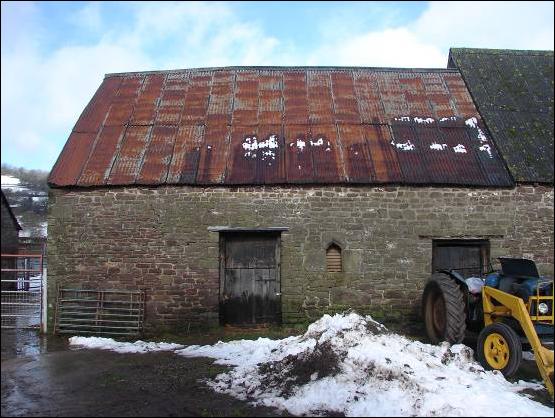
Figure 20: S elevation of Stanton chapel with lancet window to left of doorway (Author’s photograph, 11th February 2007).
More specifically, what does the evidence tell us about the impact of the Priory on the development of historic landscape features in a number of thematic areas (see figures 16 to 20):
q The home grange and Priory surrounds
q Manorial estates, including churches and chapels
q Granges
q Farmsteads
q Field patterns and agricultural land-use
q Roads and trackways
4. Research Methodologies |
| “…the field archaeologist is one who walks over the country observing and recording the remains of the past that are visible on the surface or are indicated by superficial remains…” (Crawford, 1953, p36) |
In many ways this study is the product of field archaeology as articulated by O.G.S. Crawford in his pioneering work Archaeology in the Field . The research methodologies employed are rooted in the empirical tradition of British landscape archaeology and history, as articulated in very basic terms by the above quote (Aston, 2004; Aston and Rowley, 1974; Beresford and St Joseph, 1958; Muir, 2001). Certainly, methodical observation-based fieldwork backed up by desk-based research using wide–ranging sources is at the heart of this landscape study. The multi-disciplinary methodologies that this implies, embracing ecology, historical geography and local history, also avoid too narrow a focus on the material culture (Muir, 2000; Rackham, 1986).
However, the relatively conservative and unreflective approach that locality-based fieldwork can lead to is criticised with good reason and needs to be avoided (Johnson, 2007; Knapp and Ashmore, 1999). The aim here is therefore to try and frame the large amount of local detail that this study has brought together within the theoretical constructs and socio-economic concepts that underpin our understanding of the development of historical landscapes (Johnson, 2007; Jones and Page, 2006).
| 4.1 Field visits and photography |
A commitment was made to visit, photograph, sketch and take notes on sites, features, buildings and the wider landscape generally as comprehensively as possible. This led to twelve full days of fieldwork and reconnaissance over a period of a year, encompassing a wide range of weather, visibility and ground conditions. This work provided not only much of the material for this study, but also a deeper understanding of and feeling for the local landscape and topography. Whilst desk-based research formed a much larger proportion of the time spent on this project, the fieldwork was vital in ground-truthing to inform and direct the research.
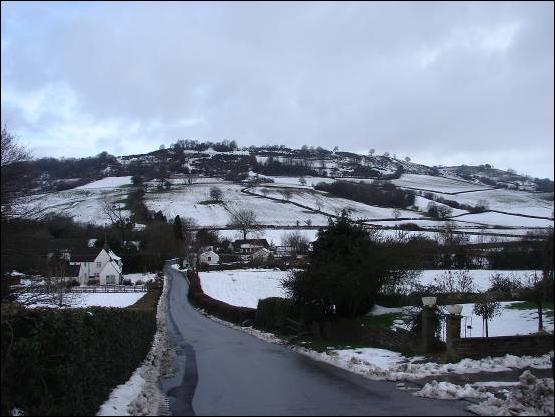
Figure 21: Main road into the Vale of Ewyas from Llanvihangel Crucorney, looking N (Author’s photograph, 11th February 2007).
Landscape is by definition a visual subject and good quality photography is an important tool to help the landscape archaeologist bring the subject to life. A large number of photographs of buildings, earthworks, field systems and other landscape features were taken and form a significant component of the final report. Digital photography enables high quality images to be included to record features and help illustrate and supplement interpretation of the landscape, often more effectively than words (Bowden, 1999).
The field visits were also crucial in helping to identify locations for further investigation via documentary search, map regression and earthwork survey as outlined below.
| 4.2 Earthwork survey |
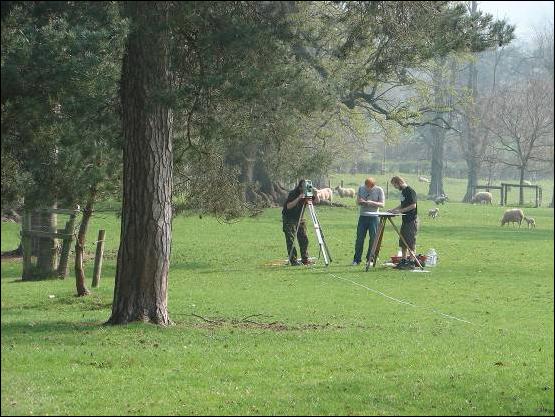
Figure 22: Total station and plane table in use for the Tre-wyn survey (14th April 2007).
A number of potential sites for analytical earthwork survey and further archaeological work were investigated and are listed in Appendix 6. However, although there is great potential for further fieldwork at a number of locations, the time and word-count restrictions of this project mean that one site has been chosen as a fieldwork case study. The site selected was at Tre-wyn in the southeast of the valley, which initial desk-top investigation and field reconnaissance identified as the probable site for the medieval chapel of St Martin’s, a possession of the Priory[7] .
| 4.3 Documentary sources |
The primary documentary sources for Llanthony Prima are limited and there is no cartulary[8] . Primary sources for Llanthony Secunda are more evident and the Llanthony Priory Registers 1457-66, 1501-25 edited by John Rhodes provide a degree of information on Llanthony Prima’s estates.
|
Figure 23: Extract on Llanthony Prima from Valor Ecclesiasticus (After Caley and Hunter, 1814). | John Rhodes’ article in Glevensis provides a useful summary of the recorded holdings of Llanthony Prima. There are two key historical records, both detailing taxable revenue for monastic houses, that provide contemporary information on monastic holdings: The Ecclesiastical Taxation , authorised by Pope Nicholas IV in 1291 and the Valor Ecclesiasticus of 1535. Copies of these and other |
historical documents held by the University of Bristol library were also consulted.
David Robinson’s extensive, though now quite out of date, survey of The Geography of Augustinian Settlement provided further detail on the Llanthony estate and comparisons with other houses, whilst David Williams’ exhaustive study of the estates of The Welsh Cisterians also provided comparative information. The two recent general works on monasteries and landscape, Mick Aston’s Monasteries in the Landscape and James Bond’s Monastic Landscapes were also consulted heavily.
David Evans’ two reports on the excavations on the Priory site in the late 1970’s provided the only archaeological evidence from the modern period for the study area and provided invaluable information on the precinct and economy of the Priory.
A number of nineteenth and early twentieth century antiquarian and topographical studies describe Llanthony and other parts of the study area and provided useful background information. The most detailed of these is Bradney’s History of Monmouthshire , which has provided valuable topographical information and detail on the Priory’s holdings at Dissolution and the ownership of the estates through to the nineteenth century.
A large number of sources on landscape archaeology and history, monasteries, historical geography and local, regional and Welsh topography and history were also consulted to provide background information and detail on specific issues, as listed in the bibliography. The National Library of Wales, the Arts and Social Sciences, Continuing Education and School of Geographical Sciences libraries at the University of Bristol and the University of Cardiff library, as well as local second hand and on-line bookshops provided many of these reference sources.
| 4.4 Historic Environment and other records |
Visits were made to the Welsh National Monuments Record (NMR) in Aberystwyth and the Glamorgan and Gwent Archaeological Trust Sites and Monuments Record (GGAT SMR) in Swansea to consult relevant records and documentation held there and a print-out received from the Clwydd and Powys Archaeological Trust (CPAT) SMR covering the northern part of the study area. The Coflein and CARN on-line databases and the on-line Historic Environment Record (HER) for Herefordshire were also interrogated for relevant information.
The Gwent Records Office at Cwmbran was visited to consult a number of relevant historical documents and the extensive notes and papers on the history of the Priory and the surrounding area produced by the late Charles Knight, owner of the Llanthony Abbey Hotel during the 1960’s and 1970’s.
| 4.5 Aerial photographs, maps and plans |
A list of the historic and modern maps and plans used for the project is included at the end of this report. Modern and historic Ordnance Survey map tiles covering the study area were downloaded from Digimap™.
Copies of early nineteenth century tithe maps covering the whole study area and their accompanying apportionment schedules were obtained from the National Library of Wales. These provided valuable information on field names, land-use and changes in field morphology. Except for a 1726 map of the Tre-wyn estate, no detailed maps or plans for the study area earlier than the tithe maps were located and this proved a hindrance to creating a picture of the temporal development of the landscape.
Copies of aerial photographs of the study area were obtained from the Royal Commission on Ancient and Historic Monuments (Wales) and the GGAT SMR. Satellite images of the study area were also downloaded from Google Earth™.
| 4.6 Place, field and feature name analysis |
|
Figure 24: Sign for Llwyncelyn Farm, meaning ‘holly bush’ in Welsh (Author’s photograph, 11th February 2007). | In order to assist with the interpretation of landscape features, a glossary of Welsh words in place and landscape feature names was developed from a range of sources (see SI2). This then enabled a systematic list of the meanings of all the settlement, farmstead and landscape feature names in the study area to be produced (see Appendix 5). Welsh place and |
feature names, particularly farmstead and field names, are very descriptive in topographical terms and this proved an invaluable reference source for identifying sites and features to explore further and to help interpret the landscape generally (Richardson, 2002).
The glossary of Welsh topographical words and John Field’s English Field Names were used in an exercise to plot nineteenth century field name meanings and land-use, as recorded on the tithe apportionment schedules, on the copies of the accompanying tithe maps. This provided:
q A picture of the nineteenth century agricultural landscape;
q Etymological evidence of known and previously unidentified landscape features;
q Evidence to help build up the speculative maps for the manorial holdings;
q A resource for assessing the distribution of English, Welsh and hybrid field names and different types of field name.
| 4.7 Geographical Information Systems (GIS) |
The GIS package MapInfo™ has been used to produce digital map outputs of the research data to illustrate and support the findings. Geo-referenced modern and historic Ordnance Survey maps, aerial photographs and satellite images have been used as base layers. Data from field visits, HER records and other sources has then been tabulated into layers and plotted on the maps.

Figure 25: Radclyffe’s early nineteenth century view of Llanthony Priory (After Coxe, 1830).
|
| 5.1 Origins and history of Llanthony Priory |
| “…a humble chapel of David the Archbishop (St David) formerly stood decorated only with moss and ivy…a situation truly calculated for religion and more adapted to canonical discipline than all the monasteries in Britain.” (Gerald of Wales (Giraldus), The Journey Through Wales, 1188) |

Figure 26: E elevation of the Priory church nave (Author’s photograph, 3rd August 2003).
In many ways the siting of Llanthony Priory[9] in an upland valley was atypical for an Augustinian establishment, which tended to favour areas with good quality arable land, and was more characteristic of the location for a Cistercian house (Cowley, 1977; Williams, 1975)[10] . However, monastic houses established in the hermatic tradition of St Augustine and the Cistercians were often located in rural locations associated with a hermitage and which accorded with classical ideas of wilderness (Aston, 2000; Johnson, 2007; Robinson, 1980). Llanthony’s origins mark it out as a prime example of this pattern (Dickinson, 1950; Evans, 1984). As Robinson (1980) has pointed out, there was generally a lack of uniformity in the spatial and temporal spread of Augustinian houses, partly due to the flexibility and lack of prescription of the Rule of St Augustine itself. In any case, the topography of the Vale of Ewyas was well-suited for locating a monastic establishment: “The ideal rural monastery was situated in an isolated river valley, providing shelter, fresh water, timber and land for cultivation” (Gilchrist, 1999, p238).
|
Llanthony The modern spelling of Llanthony is a corruption of Llanddewi Nant Honddu (meaning ‘The church of St David on the Honddu brook’) (Bradney, 1907; Davies, undated; Evans, 1953; Owen, 1998). Honddu derives from old Welsh words for ‘easy, pleasant, quiet’ and ‘black’ and is a descriptive name for the river running through the valley (Lewis, 1960; Owen, 1998).
|
The foundation and early history of Llanthony are well documented and come from a history recorded in the late twelfth or early thirteenth century by an anonymous canon (Evans, 1953; Evans, 1984; Fancourt, undated). The hermitic origin relates to the legend that St David had built a simple chapel in the valley in the sixth century and lived there in solitude for several years. It was on discovering the ruins of this cell whilst out hunting that the Priory’s founder, William de Lacy[11] , is said to have renounced his secular life and taken up a pious hermitic existence (Barber, 2003; Evans, 1953). After several years Ernisius, a chaplain of Queen Matilda, joined de Lacy and together they established a religious house under the order of the Black Canons of St Augustine. The first church was consecrated in 1108 and dedicated to St John the Baptist (Evans, 1984; Newman, 2002). The original building (see figure 27)[12] has been suggested to be on the site of St David’s original cell, although other possible locations at Henllan two miles to the south or Capel-y-ffin to the north have also been postulated (Bradney, 1907; Evans, 1984).
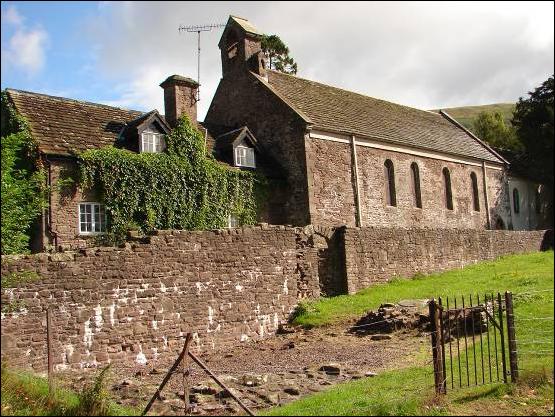 Figure 27: W elevation of St David’s Church, Llanthony on the site of the original Priory church (Author’s photograph, 26th August 2006).
Figure 27: W elevation of St David’s Church, Llanthony on the site of the original Priory church (Author’s photograph, 26th August 2006).
The Priory prospered in its early decades and benefitted from the patronage of King Henry I and local barons. The Lordship of Ewyas[13] , held by the powerful de Lacy family, controlled the area at this time and Hugh de Lacy endowed the Priory with lands and tithes in the area[14] . The de Lacy’s administered their territory from castles at Ewyas Harold and Ewyas Lacy, now
|
Figure 28: Longtown Castle (Author’s photograph, 26th December 2006).
| ||
Longtown (see figure 28) (Stanford, 1980)[15] . The Domesday Book includes a reference to Roger de Lacy owning “…an estate called Longtown within the boundary of Ewias. This land does not belong to the jurisdiction of the castle nor to a hundred” (Martin and Williams, 1992, p507). Thus the area was on the very margins of Norman control and influence, and in terms of population and social structure largely Welsh (Lloyd-Jones, 1984).
As Bond (2004) and Johnson (1996) have pointed out, the Marcher Lords used the plantation of English monks and their religious houses as a means of colonising and controlling Welsh lands. Monastic houses in border areas often benefited from the patronage and favour of both Welsh and English lords[16] , although the volatility and instability such areas experienced often militated against their development (Bond, personal discussion). The later twelfth century saw increasing Welsh rebellion and lawlessness often prevailed[17] . As a symbol of the Norman establishment, the Priory became a target for attack. Due to increasing harassment, the canons abandoned the site for a time in the 1130’s and founded Llanthony Secunda near Gloucester in 1136 as a temporary safe-haven (see figure 31).
|
Figure 29: W end of the Presbytery and Chapel (Author’s photograph, 18th March, 2007). | Even when local conditions stabilised the Welsh house was neglected until it experienced an upturn due to further support from the de Lacy family in the late twelfth and thirteenth centuries (Evans, 1984, Cowley, 1977). It was during this period, between 1175 and 1230, that the impressive precinct buildings that have survived in the form of substantial ruins were largely constructed (Craster, 1963; Newman, 2002) [18] . Hugh de Lacy and his son Walter also provided the Priory with further endowments of land, including consolidation of their |
estates in the valley and extensive holdings in Ireland. With its impressive church, precinct infrastructure and increasing number of holdings, the Priory had become a relatively wealthy monastic establishment as detailed in section 5.2 and evidenced by the data in SI1 (Aston, 2000; Evans, 1984).
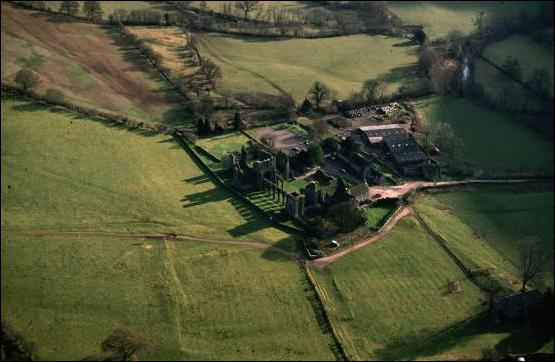
Figure 30: Oblique 1988 aerial photograph of Llanthony Priory ruins (After www.rcahmw.org.uk/ ).
However, instability remained endemic in the region and this hindered the continuing prosperity of the Priory, which experienced on-going attacks on its resources and periods of financial difficulty in the thirteenth century (Evans, 1984)[19] . This led successive priors to base themselves at the Gloucester house and the two priories were separated in 1205. Decline was gradual and there is evidence of renewed prosperity and activity into the fourteenth century, including confirmation of earlier charters of holdings, active management of its temporal possessions and a relatively high number of canons in residence (Craster, 1963; Evans, 1984; Foord, undated).
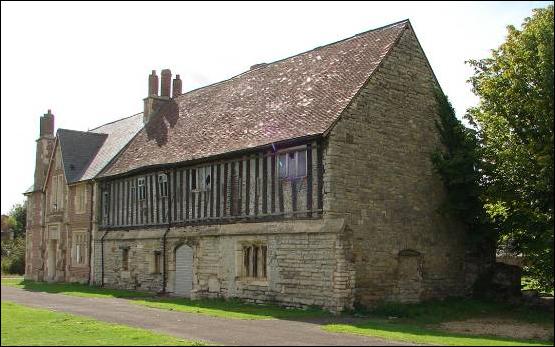
Figure 31: Surviving building of Llanthony Secunda Priory, Gloucester (Author’s photograph, 28th August 2006).
Terminal decline set in during the fifteenth century, precipitated by the Welsh uprising of 1402-06. The Priory was held and plundered by followers of Owain Glyndwr and never recovered during the preceding baronial conflicts in the Marches that characterised Henry VI’s reign (Rhodes, 2002). In recognition of its diminished status, Llanthony Prima formally became a cell of Llanthony Secunda in 1481 (Rhodes, 1989 and 2002). By this stage the fortunes of the two priories had diverged sharply and whilst Llanthony Secunda had amassed significant wealth from a large holding of churches and manors, Llanthony Prima was reduced to a community of only five canons[20] . The Priory’s final decades were characterised by decay in both the fabric of its buildings and the management of its estates (Evans, 1978 and 1984). The revenue of Llanthony Prima was £89 compared to £649 for its Gloucester counterpart at Dissolution in 1538 (Rhodes, 1989; Robinson, 1980).
At the Dissolution, the Priory, its estates and holdings was granted to Sir Nicholas Arnold, Lord Chief Justice of Ireland, of nearby Llanvihangel Court (Bradney, 1907). The Arnold family remained the owners until all of their local estates were put up for sale in 1726 and there commenced a long period of absentee landlords and neglect[21] .
| “Homeward I turn; o’er Hatterils rocks I see my trees, I hear my flocks. Where alders mourned their fruitless bed Ten thousand cedars raise their head. And from Segovia’s hills remote My sheep enrich my neighbour’s cote The wide and easy road I lead Where never paced the harnessed stead…” (Walter Savage Landor, letter to Robert Southey, 1812)
|
This story of the decline was interrupted, if not successfully halted, by the purchase of the Cwmyoy-Llanthony estate by the poet Walter Savage Landor in 1807[22] . Landor had ambitious schemes to turn the property into a grand country estate but ran out of money, local goodwill and motivation before most of his designs could be realised (Bradney, 1907; Evans, 1984). However, his imprint on the landscape remains with a number of features, including trackways, the remnants of avenues of trees and the ruin of his never completed mansion above the Priory at Siarpal . The estate remained in the hands of Landor’s family in a state of decline and neglect and was finally broken up in the early twentieth century. The precinct ruins passed into the stewardship of the Ministry of Works (now Cadw) in 1951.
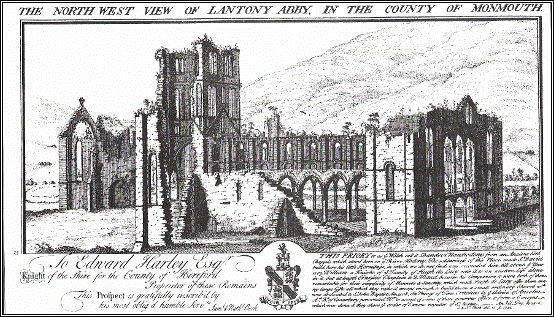
Figure 32: Buck’s 1732 view of Llanthony, the earliest known image of the Priory (After Bradney, 1907).
| 5.2 The Priory estates and holdings |
| “In a society based almost entirely on agriculture some form of landed wealth was a basic requirement for the very existence of people. Monastic life, like every other in the Middle Ages was, therefore, highly dependant on the ownership of arable lands…the Augustinians also received gifts of pasture and meadow which were used for the rearing of stock, mainly sheep, which in turn led to the order becoming a contributor to the wool trade…” (Robinson, 1980 p273). |
To begin to address the central question of the impact of the Priory on the landscape the extent of the monastic estate in the study area, its boundaries and the nature of agricultural and economic activity need to be identified
5.2.1 Extent of the monastic estate
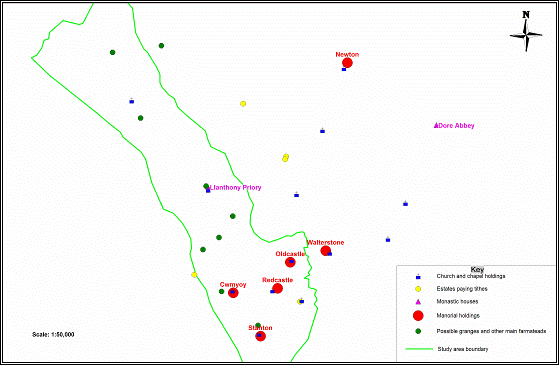
Figure 33: Holdings of Llanthony Priory at Dissolution in and around the study area (Map created in MapInfo).
The component parts of the monastic estate in the study area at Dissolution in 1538 are mapped in figure 33. Before embarking on the detailed survey in section 6 it is useful to outline the development of the documented estate, including its post-Dissolution ownership. This summary is supported by a detailed listing of the documented holdings forming part of the estate pre- and post-Dissolution in the supplementary information to this report at SI1.
The Priory was granted a number of manors in the Lordship of Ewyas and further afield by Hugh de Lacy on its establishment in 1108[23] . As Rhodes (2002) points out, except for Foxley, all the manors administered directly from Llanthony were in Monmouthshire and southwest Herefordshire. These were focused mostly in the more fertile southern areas of the valley and in the neighbouring and lower-lying Monnow and Golden valleys (as shown in figure 33). As the map of the postulated estate boundaries in the study area in figure 34 indicates, control of these estates made the canons the landlords for the vast majority of the study area, with only Tre-wyn (discussed in section 6.2), Penyclawdd, a small section of the large Llanvihangel estate to the south and the northern part of the study area beyond the Brecknockshire border outside of Llanthony’s ownership[24] .

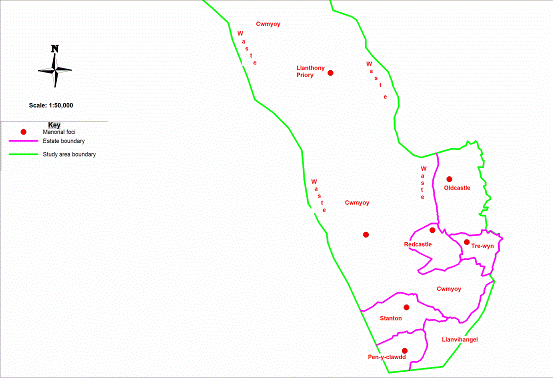
Figure 34: Map of boundaries of estates within the study area (some speculative) (Map created in MapInfo).
Firm documentary evidence for the establishment of the Priory as the primary local landowner comes from a 1324 entry in the Calendar of the Charter Rolls in which Edward I ratifies an earlier charter “…whereby Walter de Lacy[25] , son of Hugh de Lacy, gave to St Mary and the church of St John the Baptist of Llanthony Prima and the canons there for the safety of his soul and of that of Margery his wife all the valley in which the said church is situated to wit on the side of Kevencassec and Askaresweye and along the Ruggesweye up to Autefyn and on the side of Haterel from the land of Seisel son of Gilbert by the Ruggewey to the bounds of Talgarth…” (Public Records Office, 1908, p475). This can be interpreted as the Honddu Slade[26] estates encompassing Cwmyoy, Llanthony and Oldcastle, consistently confirmed as the core of the local estate in the other documentary sources (see SI1)[27] . From this early date the Priory therefore owned approximately 20,000 acres of land locally, including the moorland waste (Evans, 1984, Gardiner, 1916). The wording of the charter makes it clear that “within the bounds of the valley and throughout its lands in Ewyas the canons enjoyed a far-reaching jurisdiction over their men which extended to capital offences affecting life and limb” (Cowley, 1977)[28] .
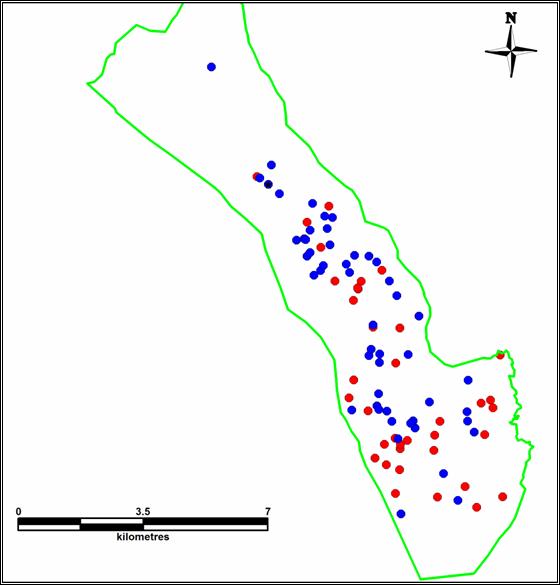
Figure 35: Distribution of the farmsteads that made up the Cwmyoy-Llanthony-Oldcastle estate put up for sale in 1799. Farmsteads on leases for life indicated in red (Map created in MapInfo).
The records for the Priory’s holdings and post-Dissolution estates through to the nineteenth century show a marked continuity in the nucleus of the estate (principally the manors of Cwmyoy, Oldcastle and Stanton in the study area and Walterstone and Newton just over the border in Herefordshire)[29] . The distribution map of the farmsteads that made up the Cwmyoy-Llanthony-Oldcastle estate put up for sale in 1799 at figure 35 illustrates that the majority of the farms within the study area were within the estate, except in the northern section[30] . The survival of monastic estates in the post-Dissolution period as discrete economic units passing into the ownership of the gentry indicates the lasting impact of the Priory on the economy and landscape of the area.
The Priory also had significant holdings in County Meath, Ireland that provided a major source of income (Rhodes, 1989). These lands were granted to the Priory by Hugh de Lacy, who had been allocated great estates in this part of Ireland in return for military service (Miles, 2005).
The primary sources for the estates of Llanthony do not specifically identify any granges in the Monmouthshire/ Herefordshire holdings, although the Priory’s extensive Irish estates did include granges (Greene, 1992; Platt, 1969)[31] . Granges were newly established outlying farming complexes set up by monastic houses outside of the traditional manorial system to exploit waste and other lands newly brought into economic use and worked by conversi (lay brothers) (Bond, 2004; Emery, 2002; Simmons, 2001; Williams, 1975). They tended to have a lasting impact on the landscape because they were “…often higher and more remote than ordinary settlements of the same period and so maintained a frontier of relatively intensive land use” (Simmons, 2001, p90).
The study of monastic granges tends to focus on the Cistercians who developed the model, which was then taken up by other orders although rarely recorded for Augustinian houses (Aston, 2000; Robinson, 1980; Saul, 2005). Where granges have been recorded for Augustinian monasteries they have tended to be relatively close to the house, reflecting the order’s limited use of lay brethren and the need for the canons to run the farm themselves (Robinson, 1980).
Unlike some other monastic orders, the Black Canons were able to serve as priests in local churches and chapels. As a consequence, Augustinian houses derived a significant proportion of their income from church possessions, spiritualities, as they provided a guaranteed income, especially where good quality arable land was not in abundance (Aston, 2000; Bond, personal discussion; Robinson, 1980). This was particularly true for Llanthony and the Priory’s holdings included a significant number of churches and chapels in the surrounding area served by the canons (see SI1), which provided a large proportion of the Priory’s income, supplemented by spiritualities on its estates in Ireland (Bradney, 1907; Cowley, 1977; Robinson, 1980).
The list of the holdings of Llanthony Prima and Secunda drawn up by Rhodes (1989) also shows that the Gloucester house had a much more significant stock of manors and other resources in its control, reflecting its development into the dominant partner[32] . This is underlined by the decline in the wealth of Llanthony Prima and the relative values of the two houses as indicated in figure 36, although Llanthony Prima retained control of its local lands until Dissolution[33] .
|
| Assessed Value of temporalities and spiritualities | ||
|
| 1291 Taxatio Ecclesiastica | 1535 Valor Ecclesiasticus | 1538 At Dissolution |
|
Llanthony Prima
|
£157 5s 4d |
£112 0s 5d |
£89 |
|
Llanthony Secunda
|
£105 15s 0d |
£648 19s 11d |
£649 |
Figure 36: Relative values of the houses of Llanthony Prima and Secunda (Bradney, 1907; Rhodes, 1989; Robinson, 1980).
5.2.2 Economic activity
The records of medieval economic activity are generally sparser for Wales than England as most areas were not covered by contemporary surveys such as the Domesday Book or the Hundred Rolls. The cultivated land within a manorial unit was divided into land in demesne[34] , land rented out to tenants, free land outside of manorial control but for which rent would be paid to the lord and small patches of marginal land exploited by the local population of villains and cottars to supply their families needs (Bennett, 1987; Dyer, 2000; Huw Jones, 1989). In the early sixteenth century the Priory had 438 acres of land in demesne, stocked with cattle and sheep and including rabbit warrens and fish weirs (Rhodes, 2002)[35] .
Robinson (1980) has compared the agricultural systems adopted by Augustinian monasteries such as Llanthony based in remote areas to the self-sufficient model adopted by the Cistercians, employing large numbers of lay brethren and rejecting feudal sources of wealth (Maylan, 2000). Certainly maintaining and developing the Priory’s estates would have required a ready supply of labour. However, a close parallel with the economy of secular estates is also likely: in line with prevailing trends in the wider land-owning community by the later medieval period most monastic lands were rented to tenants rather than being directly managed (Evans, 1984; Robinson, 1980)[36] . With the exception of the land in demesne, the Priory’s holdings would have therefore been let to tenants under the control of a steward (Rhodes, 2002)[37] . The operation of the estates was through the standard model for the manorial unit: utilising the labour services of tenants, administering affairs through manorial courts and the collection of rents from tenants by bailiffs (Cowley, 1977; Greene, 1992)[38] . However, it is also worth noting that freemen tended to predominate amongst tenants in the Welsh border areas, because agriculture was less developed and so there was less demand for “servitude based on soil” (Rees, 1924, p145). Individualistic in character, they were on the fringes of the manorial structure and, as such, helped lead to the decline of the manorial unit as a dominant feature in later medieval Wales (Rees, 1924).
As Cowley (1977, p67) notes, the Priory’s chronicler records that the land around Llanthony contained “very fruitful pastures…and rich meadows for feeding cattle which did compensate for the barrenness of other parts, and made amends for the want of corn”. Cattle rearing was certainly the dominant pastoral activity in much of upland Wales during the medieval period, although a sheep-based economy was introduced by monastic houses and Marcher Lords in the later thirteenth century to meet growing demand for wool (Huw Owen, 1989; Rees, 1924). Abbey Dore, Margam, Tintern and other Cistercian houses in the Marches maintained large flocks and the abundant moorland available to the Priory in the study area would certainly have been conducive to sheep rearing, although cattle may have continued to be the staple livestock as was the norm for smaller Welsh houses (Evans, 1984; Simmons, 2001; Williams, 1975)[39] . Sheep were reared principally for wool, with secondary products of milk and cheese. Fulling mills, the sheepcote and other landscape features discussed in section 6 are associated with medieval sheep farming (Evans, 1984).
The limited documentary evidence available demonstrates a mix of livestock activity on the Priory’s estate with cattle, oxen[40] , pigs, horse breeding and wool production important elements of the economy (Cowley, 1977; Evans, 1984). Fishing rights in the Honddu and Llangorse Lake, both abundantly stocked according to contemporary sources, and the fishponds in the Inner Court demonstrate that fish played a part in the Priory economy (Coxe, 1801; Mason, 1975). The Priory is also recorded as supplying cheese to the royal household and a sixteenth century record of the annual payment of 20lb of beeswax to St David’s Cathedral indicates bee-keeping would have been practiced (Knight, undated; Roberts, 1847). Environmental evidence from the archaeological work of 1979/80 produced the remains of cattle, chickens, pigs and sheep of medieval size and midden evidence of cattle being reared for milking as well as beef production (Evans, 1980 and 1984).
Deer remains were also prominent in the environmental evidence and the canons were granted rights to free warren within their lands (Public Records Office, 1906). The valley would have been rich in deer on its upland and heavily wooded slopes and the Priory’s chronicler and Giraldus’ account of his visit refer to their abundance (Davies, 1982; Evans, 1984; Thorpe, 1978)[41] .

Figure 37: Medieval scene of activity on a farmstead (After Dyer, 2000).
Historical records provide a number of accounts of trespass and rustling of beasts (seemingly cattle and oxen) from the Priory’s local lands, which indicate both that the canons were engaged in livestock and arable farming on a scale that aroused the interest of the local community and that they were a regular target for criminal activity[42] .
The reference to “a want of corn” quoted above may be a relative comment – Augustinian houses in other parts of the country were more heavily reliant on an arable economy. However, if arable production was less important than stock-rearing at Llanthony, it was still a significant element of the Priory’s economy. Cowley (1977) confirms arable demesne for the estate amounting to 1,080 acres (although this figure includes manorialized units outside of the study area in Herefordshire). The limited environmental evidence produced during the archaeological work carried out in the Priory precinct 1979/1980 included breadwheat, which was postulated as being an important crop grown on the estate (Evans, 1984).
| 6. Evidence of monastic landscape features in the study area: A topographical survey |
| “In the twelfth and thirteenth centuries Llanthony Prima was an oasis in a wild and barren valley. Its well laid-out gardens, orchards and well-stocked fishponds contrasted sharply with the heavily forested and rugged valley which was its setting” (Cowley, 1977 p66). |
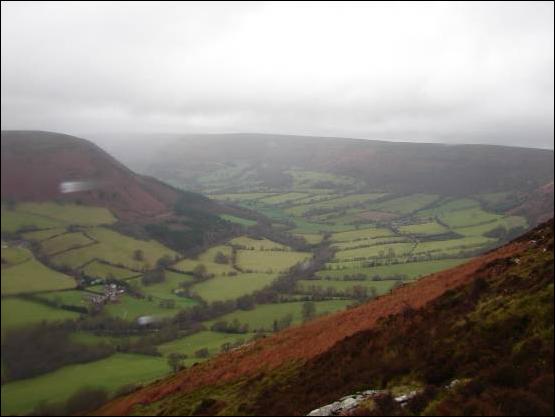
Figure 38: Panoramic view of the middle part of the Vale of Ewyas, looking N from the moorland above the Darren ridge. (Author’s photograph, 10th December 2006).
The aim of this preliminary survey of the Vale of Ewyas is to begin to establish what topographical evidence exists to indicate the Priory’s influence on the landscape and what contribution the Priory made to the mixed moorland, agricultural and woodland landscape evident today. As a summary of the evidence discussed in detail below, a tabulated checklist of the landscape features commonly associated with monastic estates and their distribution in the study area can be found in Appendix 4[43] .
| 6.1 The Priory surrounds and home grange |
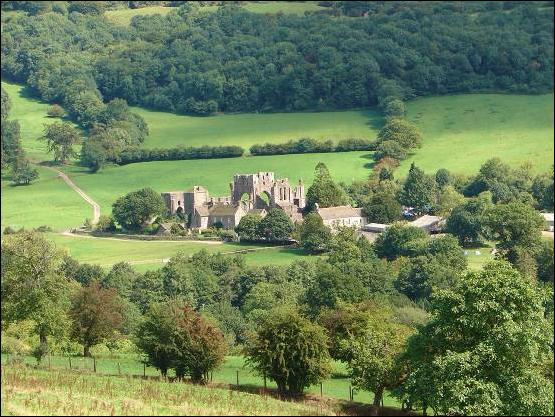
Figure 39: Llanthony Priory in the Vale of Ewyas, looking E from the W slope of the valley (Author’s photograph, 26th August 2006).
The focus here is on the wider infrastructure features of the Priory precinct and beyond that formed the home grange in their landscape setting, as mapped in figure 40 and pictured in figure 41. In general terms they reflect the resources and features that would typically be expected of a rural monastic establishment (Bond, personal discussion; Coppack, 2006). Although the immediate area of the precinct is scheduled, two of the fishponds and a number of the other features of the monastic infrastructure have been destroyed by late twentieth century development (Evans, 1984). A plan of the precinct earthworks was produced in 1979 as part of the archaeological project commissioned by the Welsh Office and can be found in Appendix 3.


Figure 40: Llanthony Priory and its immediate landscape features (Map created in MapInfo with Google Earth satellite image base layer).
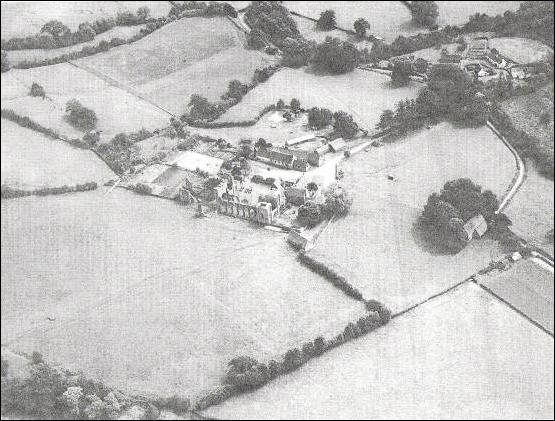
Figure 41: Oblique aerial photograph of the Priory precinct from the NW (Cambridge University Committee for Aerial Photography, 1948).
6.1.1 Inner Court Features
The Inner Cloister, Infirmary and associated domestic quarters of the precinct are not the focus of this study and have been described in detail elsewhere (Coxe, 1801; Evans, 1953; Evans, 1980, 1984; Fancourt, undated; Newman, 2002; Wade, 1909).
The Inner Court forming the south-western part of the precinct was a discrete area separated from the wider livestock enclosures to provide the monastic community with staple foods such as fish, foul, eggs, vegetables, fruit and herbs (Aston, 2000; Evans, 1984). The Priory’s gardens and orchards have been recorded as extending to 12 acres and would have probably been located within the Inner Court (Briggs, 2005).
|
Figure 42: Remains of the dovecote (Author’s photograph, 27th August 2006). | The remains of a dovecote were discovered in the early twentieth century and investigated in detail during the archaeological work of 1979/80 (see figure 42). Its form indicates medieval origins with continuing use and refurbishment into the eighteenth century (Bond, 2004; Evans, 1984). The dovecote is given as evidence of a lack of arable crops in the nearby demesne (Evans, 1984). |
A series of three fishponds[44] have been identified amongst the earthworks in the Inner Court[45] . Although interpreted as contemporary with the Priory, Landor’s improvements in the early nineteenth century included re-stocking of ponds and so their form may have been altered or, in the case of the most westerly, there may even be a case for post-medieval origin (Evans, 1984).
6.1.2 Outer Court and Enclosures
The precinct comprised an area of around 16 hectares bounded in part by a substantial stone wall, indicating the defended nature of the Priory in an often hostile locality[46] . Large yew trees mark the boundary in at least three of its corners. Yews are often associated with long-standing boundaries, meeting places or prominent positions on routeways (Bevan-Jones, 2002; Muir, 2005)[47] . The outer part of the precinct was divided into a large northern enclosure, with an Outer Court that probably contained the farmyard and agricultural outbuildings of the home grange, a tannery, dairy house, animal housing, accommodation and stabling for visitors and travellers, and a southern enclosure subdivided into fields for grazing (Bond, 2004; Coppack, 2006; Evans, 1984). Typically, smaller Augustinian houses with an economy based on pastoral rather than arable farming would have a less well-developed infrastructure of barns and other buildings for grain storage etc. (Bond, personal discussion). The evidence of quite a significant cluster of such buildings within the precinct and of arable production as discussed elsewhere in this study indicates a more mixed economy of agricultural activity.
The Outer Court included the Priory’s large main estate barn (SO288279), the
|
Figure 43: Earthwork platform for the main Priory barn in The Warren field, looking N (Author’s photograph, 11th February 2007). | location of which is marked by a rectangular earthwork platform in The Warren field of approximately 50m in length (see figure 43) (Evans, 1984; Gardiner, 1916). Such monastic barns, often wrongly labelled tithe barns , were used to provide secure storage for the produce from the demesne land and other manorial holdings (Aston, 2000). Arable production would |
seem to have been concentrated on demesne lands at Cwmyoy (see sections 6.3.1 and 6.6) and other outlying manors. Security considerations and the use of the arable produce for domestic consumption at the Priory or as a raw material for the mill and other ancillary units, such as a bake-house or brew-house, would account for the siting of the barn here. Although there is earthwork evidence of ridge and furrow patterns in the fields of the enclosure, the narrow straight-line character probably indicates post-medieval origin (Evans, 1984; Taylor, 1975). The Warren and Clapper field names in the enclosure (see figure 40) indicate extensive rabbit farming, an important source of food in the medieval period (Bond, 2004; Simmons, 2001).
The main gatehouse (SO287278) is still extant as a post-medieval barn that now stands in isolation from the rest of the buildings at the bend in a dog-leg of the main valley road (see figures 44 and 45). The original entrance trackway from the gatehouse to the Priory only remains as a faint holloway and has been replaced by the modern access road to Court Farm and the hotel and ruins.
|
Figure 44: The S elevation of the gatehouse with the holloway that formed the original main entry route to the Priory in the foreground (Author’s photograph, 26th August 2006).
|
Figure 45: W elevation of the gatehouse, showing the original entrance to the Priory (Author’s photograph, 26th August 2006). |
Place and field name evidence from the wooded slopes of the hillside to the north and west of the Priory enclosure may indicate the existence of a monastic park[48] , although they could originate from Landor’s abortive project to create a landscaped country house estate.
6.1.3 Mill, millpond and associated features

Figure 46: Oblique aerial photograph of Llanthony Priory with the mill pond site top right (RCAHMW,1992).
|
Figure 47: The mill-leat, looking SW from the main valley road (Author’s photograph, 11th February 2007). | Harnessing water resources was an important element of the monastic economy and such activity had a significant impact on the landscape through sophisticated water management systems associated with fishponds, drainage, water supply and mills (Aston, 2000). The documentary sources for the Priory’s holdings consistently include reference to a mill, with the |
earliest recorded date the original establishment of the church in 1108 (Rhodes, 1989). The hamlet of Llanthony has a long-established mill site (SO28627) [49] with a surviving 300m long mill leat (see 47 figure) and the remains of a large millpond (visible in the aerial photograph at figure 46) in an area of boggy ground adjacent to the river.
The mill may have been used for milling corn, flax or flour from the bread-wheat produced by the estate and so have been operated as part of chain of production in the landscape including the arable fields around Cwmyoy and other estates, the great barn where the wheat was stored and the bakehouse and other domestic facilities in the precinct for which the mill’s produce was used as a raw material. Sheep-rearing estates often also had a mill for fulling (processing wool) and this would be an alternative function (Williams, 1983).
6.1.4 Sheepcote
| Immediately south of the Priory’s South Enclosure lie Bugle Bridge (SO291273), carrying the main valley road over the Honddu, and a field significantly larger than those around it with a terraced character (SO292275). This field was divided into two on the tithe map, Bugley meadow being the lower and Quarry meadow the higher portion (see figures 40 and 49). It is the meeting point for a number of tracks and traversed on its western side by the main valley road and the river and on its northern side by a |
Figure 48: Holloway from Bugley meadow to the uplands (Author’s photo, 8th May 2007). |
disused holloway up to the sheep runs on the east side of the valley (see figure 48). Bugle and Bugley can be interpreted as anglicised versions of the Welsh bugail, meaning ‘shepherd’.
Monastic estates in upland areas for which sheep were one of the key components of their economy would have required a large sheepcote down in the valley for housing the flock during the winter months (Aston, 2000; Williams, 1984). This would have been located close to the monastic house, one of its manors or granges and characterised by a long (in excess of 100ft) timber or stone building (Bond, 2004). The lower terrace within Bugley Meadow conforms to the dimensions for a platform for such a building. The earthworks, name evidence, location with good access to the river for sheep dipping and washing and at a meeting point for significant trackways from other parts of the valley, would seem to indicate that this is a likely site for Llanthony’s sheepcote[50] .
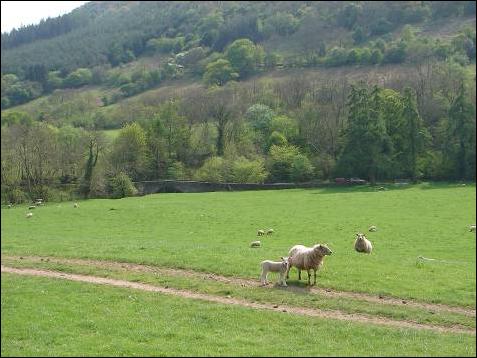
Figure 49: Bugley meadow looking SW downslope to Bugle Bridge with the platform earthworks visible in front of the bridge (Author’s photograph, 8th May 2007).
| 6.2 Fieldwork case study: Tre-wyn – earthwork evidence of a monastic holding |
| “There was a chapel at Tre-Wyn dedicated to St. Martin. The site is uncertain, but it stood somewhere in the meadow on the left of the approach to the house. The tithes and advowson of this chapel belonged to Llanthony…” (Bradney, 1907, p241). |

Figure 50: Tre-wyn house looking SW from the lane. Chapel field earthworks to the left and earthworks in the dovecote field to the right, with the remains of the seventeenth century avenue of Scot’s Pine on both sides of the lane (Author’s photograph, 26th December 2006).
| 6.2.1 The Manor of Tre-wyn |
The present manor house at Tre-wyn (SO329228, meaning ‘house of Wyn’, see figure 50), which lies at the foot of the southern promontory of Hatterrall Hill, is largely of seventeenth century fabric but has evidence of late medieval origin and an eleventh century fortified hall has been postulated for the site (Bradney, 1907; NMR 20926; Newman, 2000). The Winston family established the manor with sixteenth and seventeenth century records evidencing its early development[51] . In the seventeenth century the estate was incorporated into that of another large house, Alt-yr-ynys [52] (SO335234), just over the river Monnow and the Anglo-Welsh border.
Tre-wyn manor house was not one of Llanthony Priory’s manorial holdings[53] , but a Chapel of St Martin at Tre-wyn is listed in Valor Ecclesiasticus and in the records of the Priory’s’s estates at Dissolution (see SI1). Rees (1933) records Tre-wyn as the site of a chapel appropriated to a monastic house in his survey of medieval South Wales and the chapel is recorded as extant in the fourteenth century in the GGAT SMR (01632g). Tre-wyn is also mentioned as one of the places of pilgrimage on the way to Llanthony (Bradney, 1907) (see section 6.7.3). Although the 1726 estate plan for Tre-wyn (see figure 51) shows a building in Chappel yard , the documented seventeenth and eighteenth century leases, concords and sales for the estate do not mention a chapel in the list of holdings of the manor, indicating that it had probably already fallen out of use by this stage.
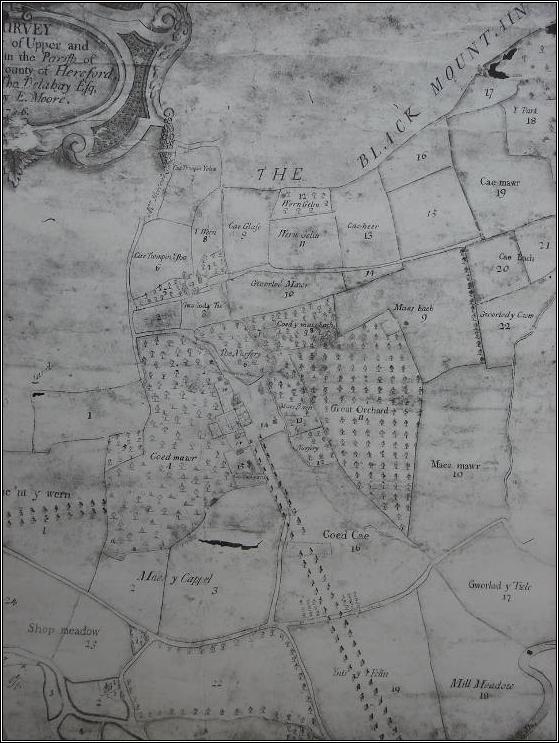
Figure 51: Extract from the 1726 Tre-wyn estate map (Author’s photograph, reproduced by kind permission of Valentine Walsh).
Tre-wyn displays significant physical evidence of a post-medieval designed landscape and an earlier manorial estate. The particulars of the 1775 sale of the estate (see SI1) include 310 acres of land in demesne and the 1726 plan (see figure 51) indicates a land-use mix of orchards, woodland, riverside meadow and pasture bordering the upland waste of Hatterrall Hill. The buildings clustered around the manor house include a coach house, smithy and carpenter’s shop with the estate completed by a mill (Trewyn Mill, SO334233)[54] and a home farm (Trewyn farm , SO227327, see figure 52). Of particular interest in the vicinity of Tre-wyn House are a dovecote of seventeenth century origin (see figure 53), a series of fishponds, which would appear to have been constructed as part of the eighteenth century designed landscape but may be of earlier origin (Muir, 2000), and an unusual folly -style structure of unknown origin or function in the gardens (see figure 54).
|
Figure 52: Trewyn Farm (Author’s photograph, 26th December 2006).
|
Figure 53: Dovecote at Tre-wyn (Author’s photograph, 11th February 2007). Figure 54 opposite: Building of unknown function in Trewyn House gardens (Author’s photograph, 31st March 2007). | |
| 6.2.2 Survey methodology |
| |
The field selected for survey was chosen for the following reasons:
q It conformed to the site of the chapel and enclosure on the 1726 estate plan and in Bradney’s 1907 description above;
q Initial reconnaissance revealed it contained a number of clear linear and irregular earthwork features;
q It was known to the landowner as Chapel field and appears as Chappel yard on the 1726 plan;
q The field and surrounding landscape has not previously been subjected to survey or other archaeological investigation;
q The chapel site does not currently have any archaeological record at county or national level;
q It is under grazed pasture with no scrub cover and therefore presents the ideal conditions for earthwork survey.
|
Figure 55: Total station and plane table (Author’s photograph, 14th April 2007). | The survey took place over the weekend of the 14th and 15th April 2007 in dry and bright conditions. Ground cover was close-cropped grass, maintained by a flock of sheep. The field, which slopes gently from southwest to northeast, contained a number of mature trees and saplings, which had to be circumvented to ensure good visibility for readings. A baseline was established at a known point on the boundary wall of the house gardens and ran the length of the field for 100m, parallel with the line of the modern lane. The Leica TCR 307 Total Station was set up at a |
point half-way down the slope of the field with good visibility of the whole area. The majority of readings were taken with the Total Station and plotted from the baseline, except the final 20m of the northeast end of the holloway which were recorded using tape and off-sets and an optical square. A plane table was used to plot the readings and the field plan was traced to form the final inked plan at figure 57.

Figure 56: Boundary bank (A ) and two of the ancient oak trees (2 and 3 ), forming the eastern field boundary (Author’s photograph, 14th April 2007).

Figure 57: Earthwork plan of site of St Martin’s Chapel, Trewyn (produced from survey undertaken on 14th / 15th April 2007).
| 6.2.3 Interpretation of the earthworks at the probable site of St Martin’s Chapel |
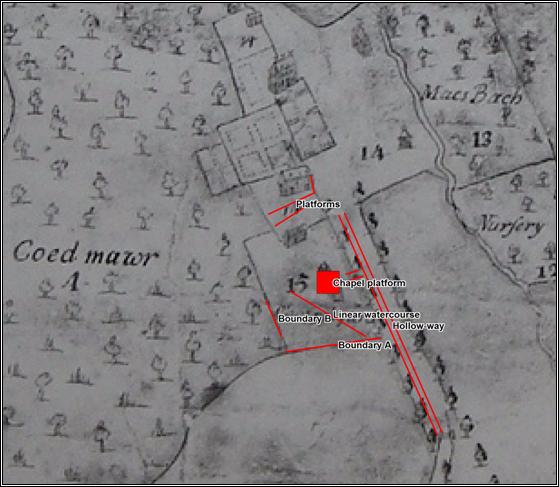
Figure 58: Features from the earthwork survey plotted onto the 1726 estate map, with Chappel yard indicated as field 15 (Map created in MapInfo).
The field surveyed is named Chappel yard on the 1726 plan, with the field below named as Maes y Cappel , meaning ‘meadow of the chapel’ (see figure 52)[55] . The name has changed to Field below the barn on the 1844 tithe map and one of the two buildings that appear between the chapel enclosure and the gardens of the house on the above estate plan may be the barn to which this field name refers.
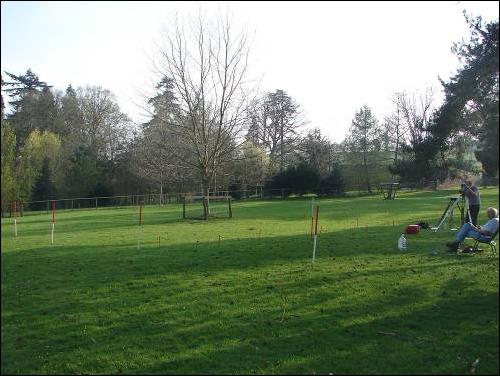
Figure 59: Probable site of chapel (C ), looking south across the E-W orientation of the building platform (Author’s photograph, 14th April 2007).
A small (15x10m) earthwork platform (C , see figures 57 and 59) was observed in the centre of the field. This conforms to the location of the building on the 1726 estate plan (see figure 51). The platform was cut into the slope at its western end and embanked on its eastern and southern sides, forming a level area within the gently sloping topography of the field. A break in the bank on the northern side of the platform is aligned with a break in the bank of holloway D (see figures 59 and 61) and may represent an entrance. Both the building on the estate plan and the earthwork platform are broadly east to west orientated (or more accurately northeast to southwest). Given the form, location, fieldname evidence and orientation of this platform, it is postulated that this was the site of the Chapel of St Martin.
The earthwork banks A and B broadly conform to the boundaries of Chappel yard in the 1726 plan (see figure 58) and can be interpreted as the remnants of the south and east sections of the curvilinear boundary of the chapel enclosure, with some evidence of an associated ditch at the southern end of bank A . It seems likely that the two banks would have been joined but the areas at either end of bank B have been much disturbed by subsequent post-medieval or modern landscaping and the original bank has been cut-through to the right of oak tree 4 on the plan.
|
Figure 60: Oak tree (3 ), looking N with boundary bank (B ) and ditch in the foreground (Author’s photograph, 14th April 2007). | Four large oak trees (1 , 2 , 3 and 4 on the plan at figure 57) are associated with the earthworks in the field: three in the boundary banks, and one bounding the holloway (see figures 60, 62 and 64). It is possible that these are remnants of the woodland that previously occupied the field (on the 1726 plan it lies on the edge of a substantial wood, Coed Mawr , meaning ‘great wood’) or post-date the earthworks. However, it is postulated here that they formed part of the original boundaries of the chapel enclosure and are examples of a relict hedgerow (Muir, 2005). |
The holloway earthwork (D , see figures 57 and 61) is parallel with the modern lane and a further curvilinear holloway in the field on the other side of the lane, all of which are bounded by an avenue of Scot’s Pines[56] . These may represent variations in the route of the track until it was formalised and straightened as part of the post-medieval improvement of the estate. The holloway has evidence of an entrance track leading the short distance from it to the chapel platform (C ).

Figure 61: Holloway (D ), looking E with probable chapel site to the right. Note the avenue of Scots Pine bounding the holloway and the modern road (Author’s photograph, 14th April 2007).
An interesting curvilinear feature (E , see figures 57 and 64) runs northeast and diagonally down slope directly past the chapel platform (C ) from a prominent depression to a smaller one at the northern end of boundary bank B . Although difficult to interpret, one explanation is that the larger depression is the site of a now dried-up spring[57] and the curvilinear feature is a channel constructed to divert the stream issuing from the spring to a small pool, dammed by the boundary bank. Given its location adjacent to the chapel, its function could possibly be interpreted as a baptism pool associated with a venerated spring (Bond, 2004).
The upper platform (F , see figures 57 and 63) would appear to conform to the location of the upper of the two buildings above the chapel enclosure on the 1726 plan (see figure 58). This may have been the barn referred to in the field name on the 1844 tithe map.
The earthworks in the field on the other side of the lane were investigated but not surveyed and may also represent features associated with the chapel or the estate.
|
Figure 62: Boundary bank (B ), looking N (Author’s photograph, 14th April 2007). |
Figure 63: Upper platform (F ) now planted with cedars, looking W (Author’s photograph, 31st March 2007). |
|
|
Figure 64: Curvilinear feature (E ), looking SE (Author’s photograph, 15th April 2007). Figure 65 opposite: Boundary bank (B ), looking E to oak tree 4 (Author’s photograph, 15th April 2007). |
In summary the earthworks can convincingly be interpreted as representing the site of the chapel of St Martin and its associated boundary enclosure and access track. The chapel formed part of a group of local spiritualities that contributed significantly to the Priory’s income and may have been a wayside chapel on the pilgrimage route that would appear to have been associated with the Priory (see section 6.7.3)[58] . The chapel may have continued to be used as a private place of worship for the estate owners for a time but disappears from the documented record in the post-medieval period and its memory only survives through the long-standing field name given to its location and the earthworks surveyed in this study.
6.3 Manorial estates in the study area |
| “In Wales the manor represented an attempt to fuse the two societies (Anglo-Norman and Welsh) by grafting onto the new the more adaptable features of the old, retaining within the new framework the elements of individual or common rights (Rees, 1924). |
In the medieval period Welsh manorial estates were mostly confined to lowland and border districts such as the study area subject to early conquest by the Normans (Watt, 2000). Such estates typically included a main hamlet (the Englishry) , a home farm and land in demesne, a park enclosed by a pale, open arable land, pasture and riverside meadows, woodland and wood pasture and scattered plots of land cultivated by farmstead tenants (Rees, 1924; Williams, 1975). Water resources were exploited by mills (often two, including a fulling mill), with fish-traps set in the weir above the mill and a leat diverting water to a millpond or direct to the mill (Rees, 1924; Williams, 1975). Access to large tracts of unenclosed upland waste provided further resources for a balanced manorial economy (Darvill, 1986). An analysis of the landscapes of the manors in the study area in the possession of the Priory is provided here.

Figure 66: Calendar, occupations of the months, 13th century (After Hassell, 1962).
| 6.3.1 Cwmyoy |

Figure 67: View of Cwmyoy, looking E from the main valley road. The yoke-shaped hill from which the manor and settlement takes its name and the landslip forming the unstable ground on which the church stands can be seen above the hamlet (Author’s photograph, 11th February 2007).
Granted to the Priory by Hugh de Lacy in 1108, Cwmyoy was by far the largest manor in its possession, covering most of the interior of the valley from the Monmouthshire-Brecknockshire border at Capel-y-ffin in the north to the boundaries with the smaller manors and estates that occupy the lower part.[59]
Settlement
The manor was centred on the settlement of Cwmyoy (SO299234, originally Cwm-iau , meaning ‘valley of the yoke’), below an area of land-slip from a spur of Hatterrall Hill (see figure 67). The hamlet, now by-passed by the main valley road, includes the parish church, St Martin , which was a spirituality of the Priory and served by its canons (see figure 69). The church, which has thirteenth and fourteenth century fabric was subject to serious subsidence during the medieval period due to the instability of the hillside on which it stands (Newman, 2000). It is likely that other buildings associated with the
|
Figure 68: Earthworks in field below Cwmyoy church (Author’s photograph, 24th February 2007). | manor, such as a smithy, bakehouse and domestic dwellings, would be clustered here. An area of visible earthworks in the small field below the church may include platforms, crofts and tofts for such buildings (see figure 68 opposite). The northern part of the settlement is known as The Pentre (Pentre-bach), meaning ‘village or principle settlement’, with the addition of bach |
(meaning ‘little’) probably indicating a farmstead at the end of the township used for winter pasture (Brown, 2004; Davies, 1982).
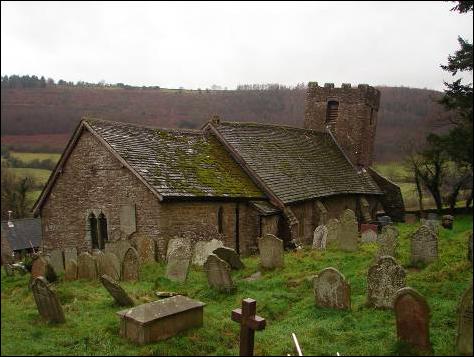
Figure 69: St Martin’s Church, Cwmyoy. The irregular angles of the building are caused by subsidence (Author’s photograph, 10th December 2006).
Demesne
The map of the speculative demesne landscape around Cwmyoy at figure 70 indicates a mix of open arable fields, water-meadows, grazing pasture, woodland and moorland waste that would form the ideal agricultural base for the Priory’s main local holding.
The large regular-shaped fields clearly visible in figure 70 and different in character to the majority of enclosures in the study area may be the location of open arable land and are discussed in further detail in section 6.6. A further interesting feature is the series of regular channels used to divert streams coming down from the hillside in the meadows north of Cwmyoy. Medieval monks were skilled hydraulic engineers and this may be evidence of drainage systems to create water meadows, although a post-medieval origin cannot be ruled out (Emery, 2002)[60] .
Farmsteads
Of the farmsteads in the immediate vicinity of the hamlet, Cwmyoy farm (SO299233) is rated as high value in the particulars of the 1799 sale of the estate (see SI1) and, along with Neuadd farm (SO295233), occupies much of the good quality land in the valley bottom. Neaudd means ‘hall’, which can be interpreted as the Welsh equivalent of manor farm (Mason, 1975). This farmstead may therefore have been the main home or manor farm of the estate. Coed farm (SO299236, previously called Ty'n-y-coed meaning ‘house in the woods’) is a likely location for the manor’s woodward , who would have responsibility for managing the estates woodland (Bennett, 1987). Smaller outlying farmsteads higher up the valley slopes, adjacent to both upland pasture and the moorland waste for cattle and sheep rearing complete the picture.

|
| Figure 70: Speculative land-use and feature map of the manorial landscape around Cwmyoy (Map created in MapInfo using vertical aerial photograph as base layer (RCAHMW, 1975)). |
Woodland
The particulars of the sale of the Cwmyoy and Llanthony estates in 1799 recorded 327 acres of woodland in the total of 12,000 acres of land in the Cwmyoy estate (Bradney, 1907)[61] . Although much of the valley would have already been agriculturally productive by the medieval period, it is likely that there would have been significant amounts of woodland, as outlined in section 6.6. As postulated in figure 70, the still substantial woodland forming Cwmyoy Wood[62] on the west side of the valley, which displays evidence of long-standing management (GGAT SMR), would have probably extended down to the river and formed a large resource for siviculture. Its extent would have then been reduced through assarting during the later medieval and post-medieval period as piece-meal extension of the area of cultivation took place (see figure 71) (Muir, 2005; Rackham, 1990).
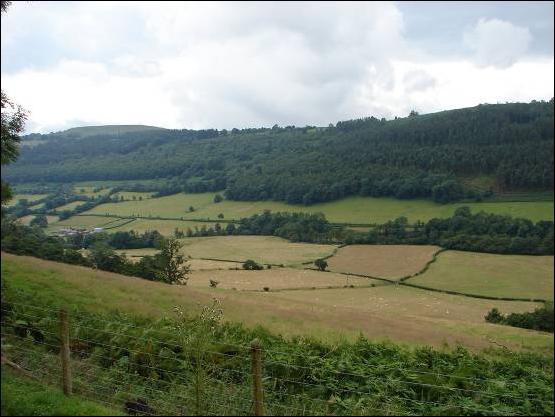
Figure 71: It is suggested that the fields below the modern tree-line represent post-medieval assarting and the woodland on this side of the valley would have extended to the river in the medieval period (Author’s photograph, 22nd July 2007).
Mill
As well as the mill at Llanthony discussed in section 6.1.3, the manor of Cwmyoy also included a mill located near the hamlet (Rhodes, 1989). Milling sites that operated in post-medieval and modern times are often characterised by continuity with mills from the medieval period (Muir, 2004). With this in
|
Figure 72: Ruined remains of the corn mill at Cwmyoy, with the mill leat channel to the left (Author’s photograph, 31st March 2007). | mind, the probable location for the manorial mill is the site of a post-medieval corn mill beside the river below Cwmyoy (SO300227), at the meeting point of a number of tracks and as indicated on the maps in figures 70 and 73[63] . Part of the mill leat can still be seen next to the remains of the mill building and running south to re-join the river (see 72 figure). A ploughed out section may have connected this |
remaining part with the river to the north (Coates and Tucker, 1978). A weir above the mill would have dammed the Honddu to divert water into the leat (Bond, 2004; Rees, 1924). The mill’s likely function would have been as a corn mill, given the proximity to the manor’s main area of arable production (see section 6.6).

Figure 73: Area around Cwmyoy mill (Map created in MapInfo using 1881 25 inch Ordnance Survey map from Digimap as base layer).
Fish-weirs
The mill dam may have been utilised as a fish-weir to exploit the Honddu’s abundant fish stocks. Fish-weirs and fish-traps were a common feature of monastic estates to harvest fish and eel stocks for domestic consumption and sale (Aston, 2000)[64] . Rhodes (1989) includes Honddu fish weirs in his list of holdings for Llanthony Prima, with a location on the river below the hamlet of Cwmyoy[65] . As well as its proximity to a probable mill dam, the stretch of river to the north of the mill has a number of characteristics that make it a possible location for fish harvesting (see figure 73). The river is relatively straight here and has several islets and channels, including a long leat parallel with the main river (see figures 74 and 75). This feature may be a fish-garth , an artificial loop in which fish were caught in staked nets (Muir, 2004). Such man-made and adapted channels would also be populated with systems of screens made of wood, wattle, turf or stone to funnel fish and eels into wicker baskets and traps (Bond, 2004; Muir, 2004; Williams, 1975).
|
|
Figure 74 above: Islets in the Honddu looking upstream from W bank (Author’s photograph, 10th December 2006).
Figure 75 opposite: Channel running parallel with main river (Author’s photograph, 11th February 2007). | ||
|
|
| ||
| The river is forded here at a point that would appear to link with an old stone bedded holloway (see figure 76) on the other side of a field that contains possible earthworks, which may be evidence of buildings associated with packing and processing of the fish caught in the traps.
|
Figure 76: Holloway at the possible fish-weir site (Author’s photograph, 10th December 2006). |
| |
6.3.2 Oldcastle |
| “The church stands on the artificial mound which in early days formed the castle. As to its foundation there is no account, but it is likely that it owes its origin to the piety of William de Lacy, the founder of Llanthony Abbey” (Bradney, 1907, p230). |
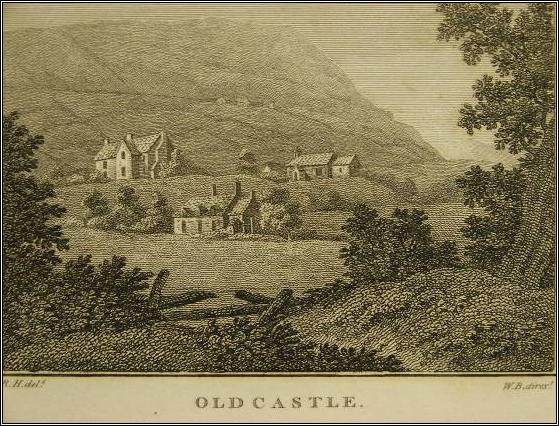
Figure 77: Early nineteenth century engraving of Oldcastle by Colt Hoare (After Coxe, 1801).
Oldcastle, in Welsh Hen-gastell , meaning ‘old castle’, was first recorded as a manorial possession of the Priory in the late twelfth century (see SI1). The manor was subject to a marked level of continuity as an administrative and economic unit post-Dissolution, remaining as a distinct estate and civil and ecclesiastical parish despite its relatively small size[66] . The manor formed an outlying encroachment of Welsh Monmouthshire into the upper Monnow valley of Herefordshire indicating its close territorial ties with the Cwmyoy-Llanthony estates to the west.
|
Figure 78: Earthwork bank to W of church, now heavily overgrown and difficult to investigate on the ground (Author’s photograph, 26th December 2006). | Centred on a farmstead cluster (SO325245), the manor was administered from Oldcastle Court (see figure 79), which like nearby Tre-wyn and Allt-yr-Ynis was home to a branch of the Cecil (originally Sitsyllt ) family, who held the property under long lease from the Priory during the monastic period (Bradney, 1907)[67] . The adjacent parish church, St John the Baptist (see figure 80), is of Norman origin |
and was another of the Priory’s spiritualities, remaining a perpetual curatesy into the nineteenth century.
|
Figure 79: Oldcastle Court Farm, a late eighteenth century farmhouse on the site of the original manor house (Author’s photograph, 26th December 2006). |
Figure 80: St John the Baptist Church, now a private house (Author’s photograph, 26th December 2006). |

Figure 81: Speculative land-use and feature map of the manorial landscape around Oldcastle (Map created in MapInfo using satellite image from Google Earth as base layer).
|
Figure 82: The manor of Oldcastle, looking NE up the Monnow valley. Court Farm and St John the Baptist Church are in the centre of the picture (Author’s photograph, 28th April 2007). | The manor occupied a rectangular block of land on ground sloping to the river Monnow forming its eastern boundary (see figures 81 and 82). The pattern of mainly larger rectilinear fields on the lower ground and smaller irregular fields as the land steepens to the Hatterrall ridge to the west that can be seen today is reflected on the tithe map. The tithe field names and land-use information suggest a pattern of meadow for cattle bordering the river, with |
significant areas of arable land and pasture higher up the valley side. A field called Sheepcot meadow suggests a sheep flock and is linked by a trackway to the open common land of the ridge. Patches of woodland remain on the higher ground and a number of fields in the northeast corner of the manor with names containing the Welsh word coed and the Old English word hirst indicate further woodland here (Field, 1989).
The manor has a network of trackways radiating out from its central hub to the ridgeway on Hatterrall Hill, and the adjacent manorial holding of Walterstone. A prominent routeway also links with the track on the west side of the Olchon valley that eventually reaches the grange site discussed in section 6.4. A number of outlying farmsteads populate the manor including a series of ruined small dwellings at intervals along a north-south trackway that traverses the boundary between the cultivated land of the manor and the open common land of the ridge[68] .
|
Figure 83: Stone drain channelling stream under a trackway (Author’s photograph, 22nd June 2007). | There is no recorded mill at Oldcastle but the tithe map records a field as Cae Hen Felin, meaning ‘old mill field’. The edge of this field at the junction of a trackway from Oldcastle to Trewyn Mill and a fast-flowing tributary of the Monnow is a possible site for a manorial mill (SO327238). There are faint hints of building platforms here and a series of shallow earthworks in the |
adjacent Cae Glas (meaning ‘green field’), which could indicate the site of mill or fish ponds. An interesting and substantial stone drain of unknown origin channels the stream under the trackway and may have been associated with the mill (see figure 83).
| 6.3.3 Redcastle |
| “Red Castle, in Welsh Castell-coch, was a small manor at the lower end of the Hattrel Hill above Tre-wyn. I have failed to find any court rolls or details of this manor. A cottage on the mountain above Tre-wyn is called The Castle (Bradney, 1907). |

Figure 84: The Castle enclosure and ruined buildings looking N, with the main track over Hatterall Hill to Llanthony and Oldcastle passing to the left (Author’s photograph, 22nd June 2007).
Redcastle[69] , originally Rubro Castro, has an enigmatic place in this study. First recorded in 1279 (Rhodes, 2002), it is categorised as a manor, rectory and church in the list of the Priory’s holdings at Dissolution and in other records (see SI1). However, Bradney (1907) confirms that he was unable to find any court rolls or details of this small manor and there is no documentary evidence of the actual location of the church and other manorial features.
|
Figure 85: The Castle enclosure looking S downhill from Hatterrall ridge, with the promontory on which stands Pentwyn hill fort further down the slope (Author’s photograph, 22nd June 2007). | One explanation for this lack of evidence may be that Redcastle was in fact more akin to a subsidiary grange for sheep, cattle or horse rearing, which all formed part of the Priory’s economy (Williams, 1974). The identified general location for the manor in the area around Upper (SO318233) and Lower (SO319228) Pentwyn (Rhodes, 1989), high up on the valley side in an area of small irregular fields and with direct access to the open moorland would |
support this theory (Leighton and Silvester, 2003). A dwelling and enclosure (SO317236) on the ridge, now ruined, is recorded on the Ordnance Survey first edition map as The Castle and Bradney (1907) remarks on a cottage at this location (see figures 84 and 85).
The English name (unusual for the area and with no recorded Welsh version) would support a new farmstead established by the canons of the Priory and the secure location high up on the ridge perhaps also pointing to a frontier settlement. The extensive ruins lie in a sheltered and south-facing location below the higher ridge and are grouped around a spring, standing in a large embanked rectilinear enclosure, lined in parts by a ditch. The main ridgeway to and from Llanthony runs directly past the enclosure and it is adjacent to a prominent system of small curvilinear fields that have a markedly different morphology to the surrounding fields (see figure 87).
Administratively, Pentwyn formed part of the Township of Bwlch Trewyn and is recorded as one of the holdings in the particulars of sale of the Trewyn estate in 1775, as is Castle on top of the hill, which can be interpreted as The Castle farmstead.[70]
|
Figure 86: Ruin in small circular enclosure adjacent to Yew Tree Cottage (Author’s photograph, 22nd June 2007). | A small chapel for the lay brothers was a common feature of grange sites and so the church may have been located within The Castle complex (Coppack, 2006; Williams, 1983). A ruined building built into the hillside in a small circular enclosure next to Yew Tree Cottage (SO314233), which stands on a trackway to Cwmyoy may be another possible location (see figure 86). |
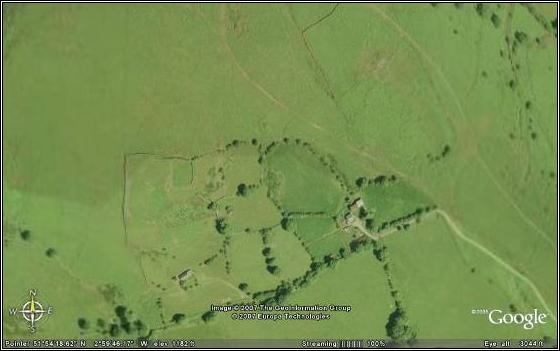
Figure 87: The Castle enclosure and ruins (top right), with the possible church site to the left of the system of curvilinear fields (From Google Earth ).
6.3.4 Stanton |
| “A mean Mannor under Lantony and its mill” (Letter from Sir John Arnold, 1728). |
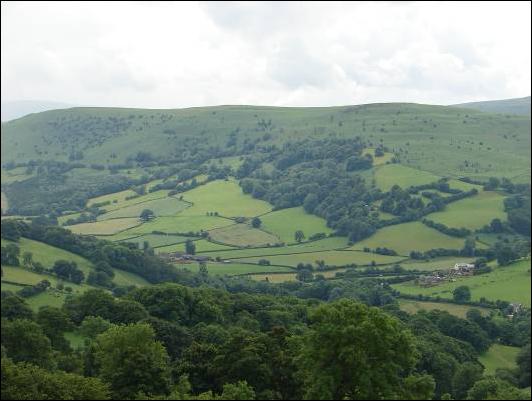
Figure 88: Landscape of Stanton manor looking SW from ridge above Pentwyn, with Upper Stanton Farm centre left (Author’s photograph, 22nd June 2007).
|
Figure 89: Ogee-headed lancet window in N wall of Stanton chapel, inside modern lean-to (Author’s photograph, 11th February 2007). | Stanton, one of the few places in the valley with an English name, meaning ‘farmstead on stony ground’, was a small manor in the possession of and possibly established by the Priory[71] , which later formed part of the Llanvihangel estates of the Arnold family. The manor comprised Stanton Manor Farm (SO312214, previously Upper Stanton ) and Lower Stanton |
(SO315210) and a small but fertile parcel of land at the mouth of the valley between the monastic manor of Cwmyoy and the seigniorial estates of Penyclawdd and Llanvihangel (Bradney, 1907)[72] . Stanton Manor Farm is a substantial farmstead that still has the remains of the manorial chapel incorporated into one of its barns, across the farmyard from the farmhouse (see figures 89 and 90). The chapel was built by the canons of Llanthony Priory for the tenants of the Stanton estate (Newman, 2000; Rees, 1933).

Figure 90: S and W elevation of Stanton chapel, incorporated into a post-medieval barn and with lancet window clearly visible (Author’s photograph, 11th February 2007).
Although the exact boundaries of the manor have not been determined, the topography of the locality mirrors that of the other manors in the study area with riverside meadows, large regular fields around the main farmsteads that may have been used for arable production and smaller irregular assarted pastures on the higher land leading to the upland common of Bryn Arw, interspersed with a belt of woodland (see figure 88).
|
Figure 91: Ford opposite Lower Stanton Farm, the possible site of manorial watermill (Author’s photograph, 11th February 2007). | A watermill and ford are recorded on Rees’ 1933 monastic map of fourteenth century South Wales. A ford crosses the Honddu opposite Lower Stanton Farm (SO316212) (see figure 91), carrying a now insignificant farm track to the pastures on the other side of the river but this does not link with any of the postulated medieval trackways and may be post-medieval [73] . |
| 6.4 Granges |

Figure 92: View looking SW from the head of the Olchon valley. The grange site and Old Abbey enclosure occupy the fields circled in the foreground on the right side of the valley, with the dog-leg track over the ridge to Llanthony also highlighted climbing the hillside above (Photograph supplied by Herefordshire Archaeology and annotated in MapInfo).
The site of a possible grange has been located in the upper part of the Olchon valley, adjacent to the Vale of Ewyas and immediately to the east of the study area. The 1840 tithe map for the Township of Llanveynoe records an area of small oval shaped enclosures in the upper part of the valley with the name The Old Abbey (see figure 94)[74] . This field system has a different character to the more rectilinear field patterns that dominate the enclosed hillside along the rest of the valley, perhaps indicating an earlier medieval origin associated with the operation of a grange (Greene, 1992). Olchon is recorded as paying tithes to the Priory in the list of holdings sold at Dissolution, although the lack of any clear reference to a grange in the primary documents is problematic (see SI1).
The potential grange site, high up on the valley side, consists of extensive ruins located within the bounds of The Old Abbey enclosure, which have been surveyed by Herefordshire Archaeology as part of the Olchon Valley Project (see figure 95). Grange complexes typically consisted of extensive areas of banked and ditched enclosures, barns, animal crofts, domestic quarters and often a small chapel (Coppack, 2006; Leighton and Silvester, 2003; Simmons, 2001). The scale and form of the relict features at Olchon would support such an infrastructure. The location high up at the head of the valley with access to exploit extensive open grazing as well as pasture is a typical one for a monastic grange operating as a bercaria (sheep station) or a vaccaria (cattle ranch) (Bond, 2004; Coppack, 2006; Locock, 2006).
|
Figure 93: The Old Abbey enclosure (oval shaped fields left of picture) looking W from above Cat Hill with the dog-leg track up to the ridge clearly visible above (Photograph supplied by Herefordshire Archaeology). | A trackway that is no longer recorded or easily traceable on the steep ground, but clearly visible as two parallel and deeply incised hollows in the aerial photos at figure 92 and figure 93, leads from the complex and follows a dog-leg course over the ridge to join the main routeway giving access to Llanthony in the next valley. The trackway that runs down slope from the site gives access to Oldcastle, Clodock |
and other locations associated with the Priory[75] . Traces of a further trackway north to lime kilns at the head of the valley are also visible.
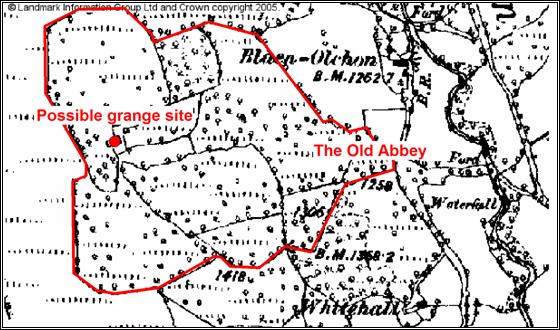
Figure 94: The Old Abbey enclosure and possible grange site in the upper Olchon Valley (map created in MapInfo, using the first edition Ordnance Survey 6 inch as a base map).
|
|
|
Figure 95: Survey plans of the grange site at The Old Abbey (courtesy of Tim Hoverd, Herefordshire Archaeology).
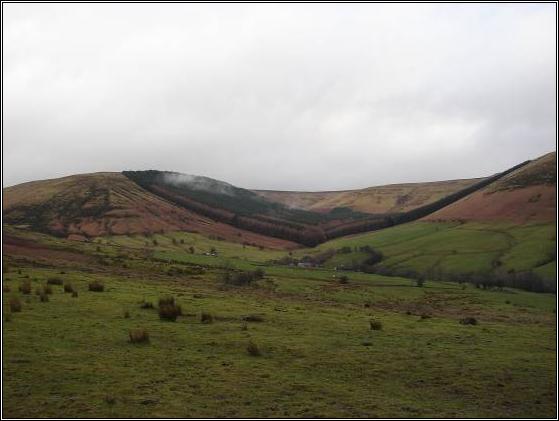
Figure 96: Parc at the head of the valley above Maerdy (Author’s photograph, 24th February 2007).
Along with the Olchon site, it may be that some of the farmsteads in the study area with possible medieval origins as identified in section 6.5 could have originated as granges serving the Priory estate. Certainly, a grange operating in the wilder northern part of the valley, or in the Grwyne Fawr valley to the west, cannot be discounted[76] . The first site for such investigation would be Maerdy (SO247334), meaning ‘grange or house of the steward’ and a place-name associated with a lordly estate, near the head of the valley (Longley, 2004). This ruined farmstead, on the route of a long disused holloway, occupies a similar location to the Olchon site and commands an ideal position to exploit the open pasture and moorland in this area for sheep or cattle farming (Silvester, 2004)[77] . The northwest slopes above Maerdy are characterised by a number of Parc/ Park names and this area is also named Park on Rees’ 1933 map of fourteenth century monastic features in South Wales, possibly indicating emparkment for game (Bond, 2004).
|
Figure 97: St Mary’s Church, Capel-y-ffin, S elevation (After Mason, 1975) | A few miles to the south lies St Mary’s Church (SO255315, meaning ‘chapel of the boundary’) in Capel-y-ffin, the only hamlet and church in the northern part of the valley (see figure 97). Bradney (1907) recorded the church as belonging to the Priory, although it does not appear in any of the contemporary records listed in SI1. The current building has eighteenth century origins with possible medieval though |
unknown antecedents (CPAT HER www.cpat.org.uk/ ). The morphology of the church’s location with its circular, llan -style boundary wall and ring of ancient yews[78] is indicative of great antiquity and has led to suggestions that it is a possible site for the original cell of St David in the valley (Bevan-Jones, 2002; Evans, 1984; Mason, 1975).
| 6.5 Farmsteads |
The settlement pattern of the study area reflects the generally more dispersed hamlet and farmstead model of western Britain rather than the nucleated vill pattern of Midland England (Bennett, 1987; Davies, 1982). However, a more finely grained and specifically Welsh Marcher character can also be discerned. In its division into upland Welshry[79] and lowland Englishry[80] , Emery (1989, p66) has characterised the Gower area in the medieval period as “… a microcism of all Wales”. A similar pattern can be seen in the study area: the incursion of Norman English influence in the more fertile areas, embodied by the establishment and estates of the Priory, with its associated land tenure, manorial and settlement organisation contrasting with the scattered farmsteads of the higher ground and upper valley preserving a pre-existing Welsh pattern of settlement, husbandry and land management (Brown, 2004; Huw Owens, 1989; Williams, 1975).
The study area contains approximately 130 farmsteads or documented farmstead sites, the majority of which are between the 200m and 350m contour. In the area south of the Priory and at the mouth of the valley the farmsteads are typically spaced at about 500m apart but the density becomes much greater in the northern part of the valley above the Priory. There are a number of larger farmsteads in the study area with possible medieval origins, generally occupying lower lying sites in the more fertile southern section, that would have operated a mixed economy of pastoral and arable farming (Brown, 2004; Newman, 2004; GGAT SMR). Examples of some of the most notable are pictured in figures 98 to 100.
|
Figure 98: S and W elevation of Noyaddllwyn farm (SO286252, meaning ‘grey hall’). There are a series of lynchet and building platform earthworks around the farmstead (Author’s photograph, 11th February 2007). |
Figure 99: Upper Henllan (SO293255, meaning ‘old church’) farmyard and nineteenth century chapel, looking E (Author’s photograph, 11th February 2007). |

Figure 100: Llwyncelyn , (SO309218, meaning ‘holly bush or grove’) looking NE from above Stanton (Author’s photograph, 11th February 2007).
The valley has a large number of small farmstead sites (see examples in figures 101 to 104) including the ruins and earthworks of abandoned holdings[81] . Many adhere to the dominant regional long house model for medieval tenant farmsteads of house, animal byre and shed in one building aligned down slope within its own surrounding close (Aston, 2004; Rees, 1924; Locock, 2006; Newman, 2002)[82] . Cruck-framed long houses are common, originally built of timber and thatched but re-clad in stone in the seventeenth to nineteenth centuries (Hassall, 1812; Muir, 2004; Rippon, 2004). Many of the farmsteads are located at a stream or spring site and at the break of slope between the pasture, arable and meadow land down hill and the rough grazing on the steeper ground leading to the moorland edge. In the medieval system of land management the meadows would have been cut for hay and fertilised by cattle with the lower lying fields providing winter pasture and the upper pasture and open moor being used in the summer (Brown, 2004).
The majority of the farmsteads are recorded in the 1799 sale of the Cwmyoy, Llanthony, Oldcastle and Llanvihangel estate (see SI1), and those with medieval origins would have been part of the Priory’s estate. It is likely that many of the larger and lower-lying farmsteads operated within the framework of an Englishry, emphasising the dominant role of the Priory on the agricultural stewardship of the study area. An alternative scenario is that the monastic estate was interspersed with independent Welshry farmsteads in a much more mixed pattern of control of the agricultural land.
|
Figure 101: Cwm Bwchel farm (SO284274, meaning ‘valley of the pass or shepherd’), an example of a typical down slope longhouse (From www.geograph.org.uk ).
Figure 103: W elevation of Ty-ddraenen previously known as Rhyddraenen barn (SO289243, meaning ‘thorn house’ or ‘ford’). Listed as a separate 40 acre farmstead in the 1799 bill of sale of the estate, the barn displays fabric of an earlier building in its walls and has a possible longhouse origin (Author’s photograph, 11th February 2007). |
Figure 102: N elevation of down slope barn at Pont Rhys Powell farm (SO313223) with distinctive cross-slitted windows on the gable end wall (Author’s photograph, 10th December 2007).
Figure 104: Upper Pentwyn farm (SO318233), looking W (Author’s photograph, 8th May 2007). |
It may be that some of the farmsteads that occupy the higher ground originated as hafodydd[83] that later became independent farm units during the period of colonization of waste and wooded lands in the fifteenth century and as the traditional system of transhumance broke down in the early post-medieval period (Bowen, 1960; Brown, 2004; Dyer, 2000; Huw Owen, 1989)[84] . As such, some of the farmsteads in the valley that have medieval origins may post-date the Priory’s heyday of economic activity and have been established by enterprising tenants rather than active land-management by the canons[85] . For instance, Loxidge (SO285286, previously known as Llociau , possibly from Llocesau meaning ‘shelter or refuge’), the name given to the hill promontory and farmstead above Llanthony to the north may indicate the location of such a dwelling.
6.6 Field patterns and agricultural land-use |
| “It is a land of deep valleys whose chequered fields, cultivated mostly for hay, reach only a little way up the valley sides before changing to the broken green of steep rough grazing which continues to the plateau tops, about 500 metres, dark with seared bracken or the shadow of heather” (Stanford, 1980, p25). |

Figure 105: Vertical aerial photograph of the middle part of the valley, with Cwmyoy to the left and Llanthony middle right. The patterns on the moorland at the top of the photograph are areas of managed burning (RCAHMW, 1975).
6.6.1 Overview of medieval land-use

Figure 106: Satellite image showing a strong visual representation of the area of cultivation in the valley (image from Google Earth)
Previous commentaries on the Priory have focussed little on the surrounding countryside. The orthodox view, based on the few documented contemporary descriptions (principally Giraldus and the anonymous Llanthony chronicler) has been that the Priory operated as an isolated oasis of civilisation and cultivation in a broader landscape of thickly forested barren waste (Coxe, 1801; Craster, 1963; Thoresby Jones, 1938; Williams, 1975). As a challenge to this view, Evans (1984) suggests that references to a number of churches and land grants in the tenth century Llandaff Charter indicate that the Priory would have been established in a pre-existing landscape of dispersed farmsteads with a pastoral economy, albeit with large tracts of woodland and upland waste, bordering estates including arable lands at the mouth of the valley.
The reference to venison and free warren in the charters granting the canons the lands around the Priory and contemporary descriptions of herds of wild deer would support a degree of open and uncultivated land during the monastic period (Davies, 1982; Public Records Office, 1906 and 1908). However, even areas used by Norman lords as hunting grounds were rarely characterised by unbroken woodland and would have included wood pasture, open moorland and cultivated land (Muir, 2000; Rackham, 1986).
Certainly, the grants of manorial units to the Priory would suggest a landscape of some agricultural potential, even if ownership of many areas of land was probably a fairly hypothetical concept in some of the remoter parts of such a volatile region. A relatively small community of canons, even if working with co-operative lay brothers, would find the clearance of large tracts of unbroken forest and waste an impossible task. It would therefore seem likely that a substantial proportion of the study area, particularly the more fertile lower lying land, would already be in some form of agricultural use or other active land management (Bowen, 1960; Emery, 1989; Sylvester, 1969).
Monastic estates were, however, at the forefront of agricultural improvement and the exploitation of new land (Aston, 2000; Donkin, 1978; Williams, 1975). The manorial system into which the Priory’s lands in the study area were organised, the evidence from the 1830’s tithe maps and the landscape that can be observed today would suggest a medieval pattern of open-field arable land[86] , meadow, assarted pasture, wood pasture, managed woodland and common waste on the high ground, in line with the standard land-use mix of the English, or in this case Anglo-Welsh, manor (Bennett, 1987).
The summary of place, feature and farmstead names in the study area provided in Appendix 5 demonstrates that the vast majority are Welsh in origin (88%). However, detailed analysis of the field names on the tithe maps reveals a fascinating mix of English, Welsh and hybrid names, with English or hybrid names more common in the lower lying land and Welsh names predominating on the higher ground[87] . There is a particular concentration of English field names around the Priory itself. This is an indication of the looseness of the divide between the two different cultures and languages in the Welsh Marches[88] .
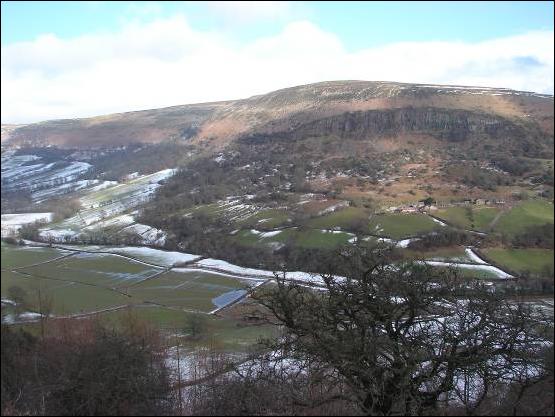
Figure 107: Looking NE to Darren crags just N of Cwmyoy. Larger regular fields on the valley floor, smaller irregular fields on the valley slopes and patches of woodland higher up with open moorland above (Author’s photograph, 11th February 2007).
The following parts of this section focus on some of the different elements of the historical field systems and land-use in the study area. Lacking any significant contemporary descriptions of the medieval or early post-medieval landscape, this analysis is largely based on field observations of modern-day land-use; topography and relict features; maps and aerial photographs; field names; and land-use evidence from the tithe maps and relevant supporting literature on landscape history. This amounts to no more than an initial and fairly broad-brush set of descriptors of the historic character of the landscape, which further fieldwork would refine.
6.6.2 Fieldscape morphology and boundary types
|
Figure 108: Assarted fields north of the Priory. The visible farmstead is called Broadley (SO283296, meaning ‘broad plain’ in Old English) (Satellite image from Google Earth ). | In broad terms field systems from the medieval and post-medieval periods conform to one of two types. Small fields with irregular boundaries generally indicate piecemeal formation, often from assarting of woodland and other uncultivated areas (Taylor, 1975). In contrast, large polygon type fields, often with more regular boundaries generally indicate planned enclosure (Muir, 2000; Williamson, 2002). |
The northern part of the study area above the Priory is dominated by small irregular fields climbing high up the valley sides characteristic of ad-hoc assarted land and possible gavelkind[89] fragmentation (see figure 108) (Brown, 2004; Donkin, 1978; Leighton and Silvester, 2003; Muir, 2004)[90] . A more mixed composition including regular linear field shapes, generally spatially located near the manorial hubs and larger farmsteads, is observable further down the valley as it broadens out and in the lower lying land around Oldcastle (see figure 105). Here, the smaller fields of the valley sides also display a more regular, rectilinear pattern with limited patches of irregular fields on the highest ground, for instance the parcels of land around Pentwyn that made up the Redcastle manor. A higher degree of planned and co-ordinated development, including assarting, is therefore observable in the fieldscape of the lands that formed the core of the Llanthony estates (Williams, 1975).
|
Figure 109: Hedge bank W of Trewyn (Author’s photograph, 26th December 2006). |
Figure 110: Stone wall and tree boundary in the N part of valley (Author’s photographs, 24th February 2007). |
|
Figure 111: Low, regular hedges S of Cwmyoy (Author’s photograph, 10th December 2006). |
Figure 112: Stone wall boundary above Cwmyoy (Author’s photograph, 10th December 2006). |
Throughout the valley a range of field boundary types can be observed (see figure 109 to 112). Field boundaries are characteristically difficult to date where documentary or map evidence is lacking (Muir, 2001; Rackham, 1986). The dominant boundary type in the study area is the mature multi-species hedge, often containing mature trees and sometimes standing on an earth and stone bank (see figure 109). Whether actual medieval relict features or more recent constructions following the line of a pre-existing boundary, the form and morphology of these field boundaries suggests a long-standing place in the landscape (Muir, 2005; Rackham, 1990). Stone wall or earth bank boundaries are common in the wilder and less wooded northern part of the study area and on the margins of the open moorland. Low and more regularly shaped hedge boundaries can be observed in some parts of the study area as discussed above and are indicative of post-medieval enclosure and re-organisation of the landscape (Williamson, 2003).
6.6.3 Evidence of open arable fields
Scattered patches of open-fields were evident in the Welsh Marches in the medieval period, interspersed within the dominant irregular enclosed field pattern (Aston, 2004; Beresford and St Joseph, 1958; Silvester, 2004). However, the countryside was generally subject to early enclosure by the fourteenth century and so this may have been a relatively short-lived feature of the landscape (Hooke, 2006; Stanford, 1980)[91] . Those lands, such as in the study area, operating on the manorial model of demesne and tenanted holdings would have included common arable fields (Huw Owen, 1989). The Priory’s demesne estate would have included arable land scattered over the common fields and interspersed with strips cultivated by tenant farmers (Rees, 1924). In an upland environment exploitation of any suitable areas of fertile land for crops would have been important and likely to produce a mixed pattern of large and small arable field types farmed through an infield-outfield system (Bowen, 1960; Rees, 1924; Taylor, 1975).
Although agricultural activity in the modern period has been largely pastoral, the land-use information provided in the tithe map apportionment schedules indicates a significant proportion of fields given over to arable use in the first half of the nineteenth century[92] . Climatic reversal and the shift towards an economy based more on sheep and cattle rearing during the later medieval period would have seen a change from an even larger proportion of arable land (Hooke, 2006; Leighton and Silvester, 2003; Sylvester, 1969; Winchester, 2000).
|
Figures 113 and 114: Two views of ridge and furrow patterns highlighted by a covering of snow in an unnamed field adjacent to Neuadd farm just outside Cwmyoy (SO294233) (Author’s photograph, 11th February 2007). | |
|
Figure 115: Possible ridge and furrow patterns in fields on the eastern side of the Cwm Iau side valley (Author’s photograph, 11th February 2007). |
Figure 116: Faint traces of flattened ridge and furrow highlighted by the snow in Abbey Meadow in the Priory enclosure (Author’s photograph, 11th February 2007). |
A field visit in February 2007 after a snow-fall revealed ridge and furrow evidence in the middle part of the valley around Cwmyoy and Llanthony, which the lack of ploughing in the modern period has helped to preserve (see figures 113 to 116). Possible lynchets can also be observed at Noyaddllwyd farm (SO286252) and south of Perthi-crwn farm (SO308242).
The large, regular field morphology in this part of the valley may indicate open field systems subject to post-medieval enclosure[93] . Whether the ridge and furrow patterns are a result of medieval ploughing or arable cultivation in the post-medieval period is difficult to establish. Certainly some display a straight rather than reverse S-shaped pattern, indicating that a post-medieval origin is perhaps more likely (Hall, 1982; Taylor, 1975)[94] . Evans (1984) dates the ridge and furrow in the Llanthony enclosure as post-medieval as it overlies the earthworks associated with the Priory. The only identified field-name evidence alluding to open arable fields is Common Field (SO299266) adjacent to Maes-y-Beran , one of the larger low-level farmsteads on the Cwmyoy-Llanthony estate.
|
| Figure 117: Twelfth century image of a Cistercian lay-brother reaping corn (After Kightley, 1988). |
6.6.4 Woodland

Figure 118: Middle section of the valley, looking NW from Graig, showing the range of woodland features in the contemporary landscape: twentieth century coniferous plantation on the upper slopes (which replaced the ancient woodland of Coed Robin); woodland along the banks of the Honddu in the centre of the picture; managed copse associated with a farmstead, centre right; and mature trees in hedgerows and alongside trackways in the foreground (Author’s photograph, 10th December 2006).
Place and field name evidence highlights the rich mix of tree species historically found in the study area, including alder, ash, beech, birch, box tree, elder, holly, oak and yew. The anonymous contemporary account of the history of the Priory provides a flavour, in the exaggerated language of the time, of the sylvan nature of the valley: “…the broken rocks were traversed by herds of wild and swift-footed animals; these rocks surrounded and darkened the valley for they were crowned with tall, towering trees…the middle of the valley although clothed with wood, and sunk into a narrow and deep abyss…” (Coxe, 1801, p215).
However, although medieval tree cover would have been greater than today, this was not a wildwood landscape but rather one of managed woodland, demarcated by ditches and banks, and wood pasture for common grazing (Davies, 1982; Rackham, 1986 and 1990; Simmons, 2001): “Surveys of some Cistercian monastery woods at about the time of the Dissolution (1536-39) reveal age structures that betoken careful sivicultural management for at least a century” (Harris, Harris and James, 2003).
|
Figure 119: Coppiced woodland near Noyaddllwyn farm (Author’s photograph, 24th February 2007). | The original grants of lands in the study area to the Priory by Hugh de Lacy and his successors gave the canons rights of timber across their holdings and this was of high economic value. Woodland was a valuable resource to be harvested through coppicing (see figure 119)[95] and pollarding for building materials, tools and a wide range of other uses, as well as providing pasture and pannage for pigs and other animals |
(Muir, 2005; Rackham, 1986 and 1990)[96] . Wood was also a valuable resource for fuel[97] .
6.6.5 The upland ridges: moorland, rough grazing and waste

Figure 120: Typical heather moorland on the high ground of the ridge on the W side of the valley, looking NE from Bal Bach. More intensive grazing in medieval and post-medieval times would have produced an upland landscape of mixed grasses rather than heather (Author’s photograph, 26th August 2006).
The broad, flat-topped ridges that flank the Vale of Ewyas are now characterised by treeless heather moorland (see figure 120). The key question relating to these upland ridges is how they were utilised in the medieval period.
Although extensive tree cover would have long disappeared, or have never existed on the thin soils of the highest ground, patches of woodland would have been a characteristic of the upland ridges in the medieval period (Rackham, 1986; Simmons, 2001). During the later medieval period and as the economic and land-use activity outlined in this study progressed, such upland areas would have been intensively grazed with mixed grasses the dominant vegetation and the remaining wood cover declining (Rackham, 1986; Simmons, 2001). The term waste often applied to such areas is misleading: this was a managed resource, intrinsically linked physically and economically to the valley below (Leighton and Silvester, 2003). Open commons provided extensive and valuable sheepwalks that formed an important element of the medieval agricultural economy and, unlike in other upland areas such as the Yorkshire Dales, were never subject to large-scale enclosure in this part of the Marches (Hooke, 2006). Horse rearing was also an activity practiced by the Priory and, as today, the large tracts of open upland grazing would have been utilised for herds of ponies. Whilst the open uplands would have still come within the jurisdiction of the lord of the manor, rights of common would have existed for the local population, closely managed by the manor steward and court (Brown, 2004; Stroughton, 2004).
Although Walter Savage Landor pushed a personal Enclosure Act through Parliament in 1813, the enclosure of the estates’ waste was never completed due to his bankruptcy and subsequent abandonment of the estate and the upland landscape has therefore remained in its open and unenclosed state.
|
Figure 121: Encroachment of fields on the western side of the valley above the 250m contour just south of the Priory, now reclaimed by woodland, scrub and moorland. Early 20th century photograph looking SW (After Wade, 1909). | An ad-hoc pattern of encroachment resulting from the intake conversion of open common into pasture is observable, in some places up to an altitude of 400m (for example, see figure 121) (Hooke, 2006). This may be a result of agricultural expansion by the Priory’s estate, piecemeal exploitation of marginal land due to the warmer climate during the twelfth and thirteenth centuries, increasing population during the later medieval period or Landor’s nineteenth century estate |
management (Aston, 2004; Brown, 2004; Evans, 1984; Locock, 2006; Rippon, 2004; Simmons, 2001).
The Black Mountains lack mineral wealth and there is no direct evidence of the Priory gaining revenue from industrial activity to exploit mineral resources (Sylvester, 1969). There is, however, abundant evidence along the ridges of quarrying to provide stone for buildings as well as lime kilns. Quarries would have been a prominent feature of the medieval landscape, supplying stone for field walls, farm buildings and, not least, the huge amounts required for the buildings of the Priory itself (see figure 122) (Leighton and Silvester, 2003)[98] .
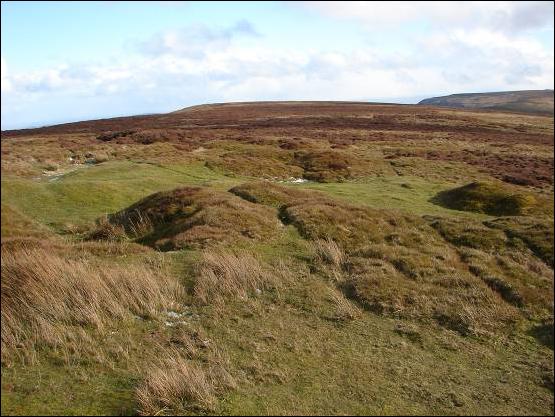
Figure 122: Quarry pits above Llanthony on Hatterrall Hill (Author’s photograph, 18th March 2007).
| 6.7 Roads and trackways |
| “I would not recommend timid persons to pass this way in a carriage, for in the whole course of my travels, I seldom met with one more inconvenient and unsafe” William Coxe’s description of the road through the Vale of Ewyas (p210, 1801). |

Figure 123: Steep banked holloway section of the main road through the valley as it climbs northwards to the Gospel Pass, half a mile N of Capel-y-ffin (Author’s photograph, 24th February 2007).
6.7.1 Medieval roads and trackways
Monastic activity was a key driver in the development of routeways across the countryside during the medieval period (Rackham, 1986). As Muir (2001, p58) points out in relation to Cistercian establishments in the north of England, “The members of the great Cistercian houses, and particularly the lay brethren who served them, needed to be on the move. Their granges spanned areas very much larger than most farms, whilst their far-flung estates involved them in considerable travel” and, furthermore, “The monks were influential, well-connected, and at first greatly respected by their neighbours. They were, in short, far better placed to negotiate convenient rights of way to link-up their scattered holdings” . The Priory would have required a network of routes for the movement of stock, people and goods to and from outlying estates and granges and to transport produce and supplies in and out of the Priory itself and the main centres of production and settlement.
|
Figure 124: The remains of the cross commemorating the murder of Richard de Clare in 1136 at Dial Garreg, looking W into the Grwyne Fawr valley (Author’s photograph, 11th February 2007). | Monastic houses were also a focus for the regular movement of monks, ecclesiastical officials and other visitors and travellers who would also need to use such routes. In hill country such as the Black Mountains high-level routes often formed a safer and easier alternative to the more densely wooded and often marshy valley floors[99] . |
Tracing the origins and routes of medieval roads and trackways is often a difficult task. As Hindle (2002, p6) has pointed out, “…essentially the road was not a physical entity, a thin strip of land with definite boundaries; rather it was a right of way, an ‘easement’, with both legal and customary status…”. As such its actual course may not have been stable over time and a series of braided holloways would often be formed (see figure 125) (Morriss, 2005). Furthermore, those routes that have fallen out of use may have largely disappeared and those that have continued in regular use into the modern period will have had their medieval surfaces destroyed or buried (Morriss, 2005). However, continued use by local farmers and/ or as rights of way has often preserved routes of medieval or earlier antiquity.

Figure 125: One of a number of braided holloways to the left of the modern road running N over the Gospel Pass indicating previous courses of the road (Author’s photograph, 24th February 2007).
Analysing the network of public rights of way is often a good starting point in recreating historic routeways. Such a network in an area of dispersed hamlets and farmsteads, when taken with other farm tracks and lanes, often provides the line of long-standing communication routes from one settlement to another. Modern rights of way can also be investigated on the ground for holloways, stone paving, earthworks and other signs of historic use (Morriss, 2005).
6.7.2 The road and track network in the study area
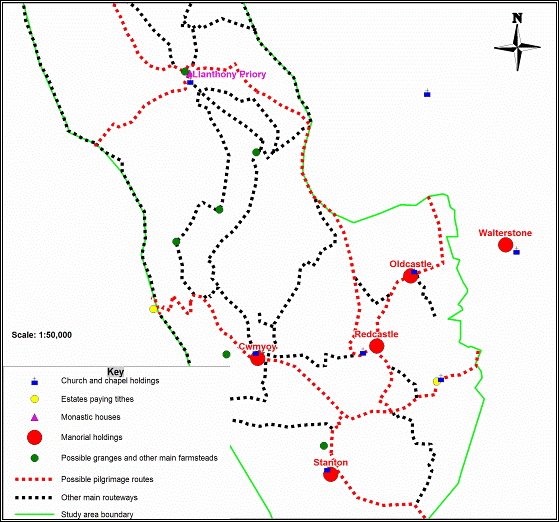
Figure 126: Speculative medieval network of routeways in the southern half of the study area (Map created in MapInfo).
From tithe and modern and historic Ordnance Survey maps it is possible to trace an extensive network of trackways radiating out from and connecting the Priory, the manorial centres, outlying farmsteads and other main settlement foci, as well as linking with the wider communication network. Some of these routes are no longer extant, such as the trackway linking the Olchon valley grange to the main ridge route described in section 6.4. However, many remain as a network of winding farm lanes, deeply cut holloways, stone tracks zig-zagging up the hillside known as rhiw and rights of way thickly spread on the modern Ordnance Survey map (see figure 129 and examples in the photographs on the following pages).
|
Figure 127: Stone pathway up valley side to Bal Bach, looking E with Priory below (Author’s photograph, 26th August 2006).
Figure 128: Stone track zigzagging from Troed-y-rhiw-gou to the W ridgeway (Author’s photograph, 11th February 2007). | One example is the trackway that climbs Cwm Bwchel west from the Priory to the cross-roads at Bal Bach on the west ridge (see figure 127). This track followed a route across the Black Mountains to Llangorse Lake in Brecknockshire, which was noted for its abundance of bream, roach, perch and pike and on which the canons had fishing rights (Evans, 1984, Mason, 1975; Rees, 1924; Rhodes, 1989; Roberts, 1847).
Many of the rhiw tracks link in this way with the ridge-top routeways that still traverse either side of the valley[100] . Now used mainly as recreational walking paths, these tracks would have formed the most direct communication and trade routes prior to the development of the modern road following the course of the river. As Bradley (1905, p101) states, “one need not suppose that the old monks of Llanthony went back and forth on the valley road…the main routes to Llanthony lay over the Hatteras ridge on the east and over the Fwddog on the west”. In his travels through the district in 1188, Giraldus arrived at and departed from the Priory using | |
|
Figure 129: Network of tracks radiating from Llanthony (Ordnance Survey 1:25,000 map extract from Digimap).
Figure 130: Part of the main valley road, S of Cwmyoy (Author’s photograph, 11th February 2007). | these ridge routes (Thorpe, 1978). The position of the two hillforts at the mouth of the valley, cairns and other material finds provide evidence of continuity of use of the ridge routes from prehistoric times (Evans, 1984; GGAT SMR)[101] .
The modern valley road is unlikely to have been in use as a continuous main arterial route in the medieval period. Certainly it shows signs of relatively recent construction in parts, particularly in the straight and wide sections in the south of the valley probably developed as a turnpike during the period of road improvement in the eighteenth century (see figure 130)[102] . The valley floor, with a mixture of cultivated land, woodland | |
and marsh, would have been unsuitable for anything more than local tracks for the canons and farm labourers to access their holdings and farmsteads.
Along with the southeast to northwest ridgeways, the main feature of the trackway network is that it mostly radiates out to the south and east (as indicated in figure 126 and Rees’ map of medieval South Wales). This reflects the focus of trade and communication eastwards to the Priory’s manors and other interests in Herefordshire and the “…king’s road from Monmouth to Llanthony Prima.” (Williams, 1976, p37). As well as a destination in its own right for visitors and travellers, the Priory would have acted as a staging post from Hereford, Gloucester and further east for travelling into Wales with the Gospel Pass providing an important medieval routeway to Hay and further north (Middle Wye Valley HLC, www.cpat.org.uk ) .
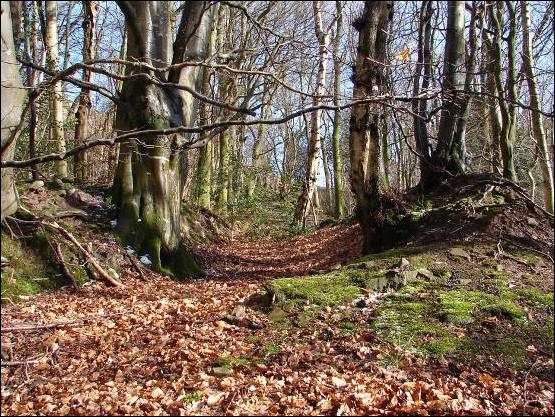
Figure 131: Holloway from Priory through Wiral wood up to the E ridgeway (Author’s photograph, 18th March 2007).
If the Priory can be seen as one of the reasons for the development and continuing utility of a network of communication routes into, out and around the study area, its dissolution is likely to have played a part in the decline of these routes into no more than a highly localised network of tracks on which the local population moved around[103] .
|
Figure 132: Pile of stones at Bal Bach marking the cross-roads of tracks from Llanthony to the adjoining Grwyne Fawr valley and the ridgeway on the W side of the valley (Author’s photograph, 26th August 2006). |
Figure 133: Holloway track up to and through Pentwyn hill fort site, looking N up the slope (Author’s photograph, 26th December 2006). |
|
Figure 134: Main track from Llanthony up to the ridgeway on the E side of the valley (Author’s photograph, 18th March 2007). |
Figure 135: Holloway track from bridge at Rhyd to the Daren farmsteads (Author’s photograph, 22nd July 2007). |
6.7.3 Pilgrimage routes
In the medieval period one of the major reasons for people to move about the countryside was visiting shrines and other religious sites connected to saints and this was a source of income for monastic houses (Adair, 1978; Hindle, 2002; Rackham, 1986). Because of its connections with St David, the Priory and other points on the way to and from it became part of the Pilgrim’s Way to St David’s Cathedral in Pembrokeshire (Knight, undated). One indicator of this tradition is that the church at Cwmyoy and chapel at Tre-wyn are dedicated to St Martin, the patron saint of pilgrims[104] .
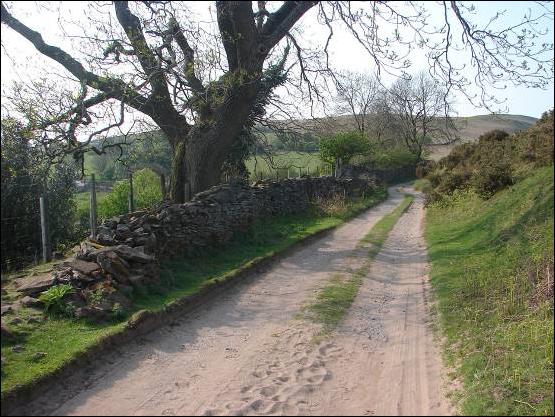
Figure 136: Ridgeway from Trewyn to Redcastle and on to Llanthony, which formed part of the speculative pilgrim’s routeways (Author’s photograph, 22nd June 2007).
|
Figure 137: The Skirrid Mountain Inn (Author’s photograph, 18th March 2007). | Possible routes for pilgrims coming from a number of directions are plotted in the map at figure 126[105] . From Herefordshire, the speculative route passes through Oldcastle over Hatterrall Hill via the church at Redcastle (see figure 136) or from St Martin’s chapel in Tre-wyn to St Martin’s church at Cwmyoy[106] . An alternative route from the south would be from the Skirrid Mountain |
Inn (see figure 137) in Llanvihangel Crucorney via Stanton chapel to the same destination. The most likely route on to Llanthony would then be via the main Hatterrall ridgeway. A northern route would enter the valley via the Gospel Pass[107] and lead down to Llanthony and Cwmyoy. Both the route up Cwm Bwchel from Llanthony or the path to Dial Gareg via Troed-y-rhiw-gou (meaning ‘foot of the hollow steep road’) are possible routes out of the valley and on to Talgarth to the northwest, perhaps via the ancient church at Partrishow in the neighbouring Grwyne Fawr valley.
The Skirrid Mountain Inn (SO325206, see figure 137) is claimed to be the oldest recorded inn in Wales (Mason, 1975). Originally called Millbrook, it was held by the Barony of Abergavenny and used as a courthouse and gaol, with a trial recorded as taking place there in 1110. Ancient inns are often associated with monasteries and provided wayside accommodation for pilgrims (Bond, 2004)[108] . The location at the gateway to the pilgrimage sites in the valley makes this a possible function of the inn.
6.7.4 Bridges and fords
Fords were a more common means of traversing rivers and streams than bridges in the medieval period, although monasteries were one of the main benefactors of bridges were they were constructed (Davies, 1982; Morriss, 2005; Rackham, 1986). The bridge at Rhyd-yr-honddu (SO289242, meaning ‘ford of the Honddu’) is recorded in the SMR (Ref 01717g) as having fourteenth century origins and is also a recorded site for a medieval ford (Rees, 1933)[109] . This would appear to be an important junction connecting the manorial foci of Cwmyoy, now by-passed by the modern valley road but reached from the bridge by a number of tracks, with the road to Llanthony via Henllan and routeways up to the western ridgeway. It seems likely that the meandering lane that then re-crosses the river at Pont Rhys Powell (SO313222) was the main low-level route linking Llanthony with its holdings in the lower part of the valley as well as forming part of the pilgrimage routes postulated above.
|
|
|
Figures 138 and 139: Footings of the original bridge at Rhyd-yr-honddu (Author’s photograph, 11th February 2007).
| 7. Conclusions and recommendations for further research |
This project has accumulated a wealth of documentary and field evidence for the study area. It is hoped that this analysis, although preliminary in nature, can contribute new information and interpretations to the current understanding of the study area and landscapes of a similar type as well as identifying future areas of research. The main conclusions from the study and recommendations for further research are outlined below.
7.1 Conclusions
Llanthony Priory was not an isolated oasis of economic activity in a wild and untamed valley. Nor were its activities unconnected to the surrounding landscape and, indeed, the vast majority of the study area was, at least notionally, under the stewardship of the canons. However, to call the area a monastic landscape would be both inaccurate and simplistic.
This is partly because the Priory saw its wealth and resources ebb and flow and finally much reduced, as its daughter priory at Gloucester flourished in a safer, more stable and fertile location. The influence of the manorial unit was also generally looser in the Welsh border area with a more independently minded peasantry less tied to lordly control. Therefore, the impact of the Priory on its surroundings was not as significant as some of the larger and more powerful monastic houses, particularly of the Cistercian order, in lowland England and South Wales and even areas of similar upland topography such as the Yorkshire Dales (Donkin, 1978; Williams, 1975).
The relatively superficial analysis of the historic landscape of the study area presented here also reveals characteristics common to many upland areas in the Welsh Marches and elsewhere, largely influenced by geology, natural environment and tenurial systems (Darvill, 1986). A mixture of small, scattered tenanted but independent farmsteads and larger manorial foci, with their associated mixed land-use of common arable fields, meadow and pasture for livestock and managed woodland, developed during the medieval period (in some cases with probable earlier antecedents). Assarting and exploitation of marginal land took place during periods of agricultural and population expansion and the upland commons were used extensively for grazing sheep, cattle and horses. These processes would have probably taken place with or without monastic ownership and stewardship of the land. As Wade Martins (2004) has pointed out, the role of individual farmers and local farming communities as key agents of agricultural and landscape change is often overlooked. A secular, seigniorial landlord would also have overseen a similar pattern of landscape development.
However, although it may be inaccurate to describe a monastic landscape, this study has shown that the establishment and functioning of a medium-sized Augustinian house over a period of over 400 years, did influence the historic character of the landscape in a number of significant ways. The developments described above may have happened anyway, but the Priory and its canons were the agents of many of these processes. In particular, thanks to the grants and endowments from the de Lacy Marcher Lords of Ewyas, they were the instrument for the consolidation of the manorial system that covered much of the study area and may otherwise have had a much looser hold on this relatively remote district (Sylvester, 1969). The continuity in the core Llanthony-Cwmyoy-Oldcastle estate into the early twentieth century is testament to the long-lasting impact of the Priory. In a more general sense this helped foster the Anglo-Welsh character of the area, creating an eastward facing agricultural community with strong and long-lasting physical and cultural links with England, albeit one with the fiercely independent nature that border areas are characterised by.
Within these general themes, and as this study has begun to illustrate, there are a number of landscape features in the study area particularly associated with or influenced by the location and activities of the Priory, as summarised below:
q Churches and chapels: In a sparsely populated area the Priory’s canons served and fostered a number of chapels and churches, four of which remained as parish churches into the modern period. The establishment of the chapels at Redcastle, Stanton and Tre-wyn was a direct result of the Priory’s location and stewardship of the area and they fell out of use after the Dissolution.
q Farmsteads and granges: Although no granges had previously been recorded for the Priory the potential grange site in the adjacent Olchon valley, the postulated function of Redcastle as a grange and other possible sites make the probability that the Priory did operate a system of granges more likely. Many of the post-medieval farmsteads that proliferate within the study area are also likely to have antecedents within the Englishry and Welshry settlement framework within the Priory’s estate.
q Field patterns and agricultural land-use : As agricultural improvers who depended on the economic proceeds of their demesne to supplement income from rents, tithes and spiritualities, the canons were one of the agents of agricultural change in the study area. In particular there is physical and documentary evidence of ridge and furrow arable fields, the introduction of a sheep economy, the exploitation of marginal land on the higher slopes and assarting to create fieldscapes from previously wooded areas. It seems likely that this agricultural activity was more significant than commonly suggested for a relatively small Augustinian house in a marginal area.
q Manorial infrastructure: The study area includes a number of relict landscape features associated with the activities of the manorial holdings of the Priory, including fishponds, mills, mill leats and ponds, sheepcotes, a dovecote, drainage systems and fish weirs.
q Roads and trackways: The links between the geographically spread manors, granges and farmsteads that made up the Priory’s estates required an efficient system of inter-linking communication routes. Trade in and out of the Priory’s estates, visitors, pilgrims and travellers to the Priory and associated sites were a further catalyst for the well-developed network of trackways that are still evidence today, with the ridge routes particularly important for efficient and safe passage through a volatile region.
7.2 Recommendations for further research
It is hoped that this study will be just the start of more detailed fieldwork and investigation into the historic landscape of the Vale of Ewyas and the wider estates of Llanthony Priory. It could also serve as part of a wider regional survey of the monasteries in the area.
The following is a brief list of the wide range of areas for fruitful future research that this study has identified:
q Earthwork and geophysical survey at the sites listed in Appendix 6.
q Geophysical survey of the Tre-wyn chapel site, further survey and investigation of the Tre-wyn estate.
q Further search for documentary records and estate maps relating to the Priory’s estates.
q Identification and mapping of the early nineteenth century landscaping and estate development carried out by Landor.
q Detailed analysis and GIS plotting of field patterns, morphology, boundary types, names etc.
q Analysis of farmstead type and morphology, including the identification of other possible grange sites.
q Landscape study of Clodock, Newton, Walterstone and other priory estates and holdings in neighbouring parts of Herefordshire.
“Landscape is very squarely about people: people who over very long periods of time have created the physical patterns of the land…” (Fairclough, 2007, p8).
Finally, with this quote and further study in mind, there is also a need to include more of a focus on the human element of the medieval landscape than this preliminary assessment has been able to. As Austin (2005, p108) points out “…from the world of the articulate monk who was artist, poet, spiritual guide, historian, politician, animal and plant breeder and so much more, we have a multitude of words and pieces of art which can inform us, in a way no other sector of medieval society can, about the wider meanings of landscape”.
[1] Ewyas or Ewias means ‘sheep district’ (or is possibly derived from Gwias meaning ‘place of battle’) in Old Welsh and was the name given to the Welsh commote and subsequently the Marcher Lordship that encompassed the valley (Coplestone-Crowe, 1989; Roberts, 1847; Smith, 2003).
[2] W hich also forms the England-Wales border on the eastern side of the valley and the boundary between the historic counties of Monmouthshire and Brecknockshire to the west.
[3] From the Act of Union between England and Wales in 1536 until 1974 most of the valley was located in Monmouthshire with the largely un-populated upper part above Capel-y-ffin lying in Brecknockshire (now Powys). Monmouthshire was subsumed into the new county of Gwent in 1974, largely with the same boundaries, and the eastern part of Gwent that includes the valley in turn became the unitary authority of Monmouthshire in 1996 (Newman, 2002).
[4] Marche translates from Norman French as ‘mark or dividing line’ between the English kingdom and the Welsh principalities to the west. (Thoresby Jones, 1938).
[5] Also variously known as Llanthony Valley or the Vale of Llanthony and, sometimes, the Honddu Valley in its upper reaches.
[6] The population of Cwmyoy, the main parish, was 511 at its nineteenth century peak in 1821 and 332 in 1901 (Bradney, 1907).
[7] A full description of the survey methodology, results and interpretation can be found in section 6.2.
[8] There is a cartulary for the Irish holdings of Llanthony Prima and Secunda but not for the possessions in England and Wales.
[9] Variously described as Llanthony Prima, Llanthony in Wales, Llanthony St John Baptist and Llanthony the First in historical sources to differentiate from its daughter priory in Gloucester, known as Llanthony Secunda, Llanthony St Mary, Llanthony in Gloucester, Llanthony-by-Gloucester, Llanthony juxta Gloucester or Llanthony the Second . Also referred to as Llanthonia and Lanton.
[10] At an altitude of 240m, one of the highest monasteries in Britain (Robinson, 1980).
[11] A Norman retainer of the Earl of Hereford and member of the de Lacy family who held the Lordship of the area.
[12] Later the Priory infirmary and chapel and, after the Dissolution, the parish church of St David.
[13] The Lordship covered the eastern portion of the Black Mountains and the neighbouring Golden and Monnow valley’s in Herefordshire. The northern part of the valley and the tributary valley of Nant-y-bwch were part of a small Marcher Lordship known as Glynbwch or Glanfach (Thoresby Jones, 1938).
[14] The twelfth and thirteenth centuries were a period when feudal lords had sufficient wealth and estates to be able to provide fledgling monasteries with the patronage and lands they needed to flourish, for reasons of personal glory, hoped for salvation and growing religious fervour (Emery, 2002).
[15] As a semi-Anglicized Welsh district, Ewyas had historically enjoyed a similar client kingdom status to nearby Archenfield in southeast Herefordshire and formed part of the militarised frontier zone used by the Norman’s to launch their ambitions for expansion into southeast Wales (Hooke, 2006; Standford, 1980; Thoresby Jones, 1938).
[16] For example, at Basingwerk in Flintshire (Bond, personal discussion).
[17] The Priory’s anonymous contemporary chronicler provides a no-doubt partisan description of the local populace: “…the people were savage, without religion, vagabonds and addicted to stealth, they had no settled abode and removed and wind and weather inclined them” (Coxe, 1801, p216).
[18] As illustrated to good effect in Buck’s 1732 engraving (figure 32) and figures 29 and 30.
[19] In the late thirteenth century the Prior of Llanthony is recorded as complaining to the crown about cattle rustling, harassment and trespass on the Priory’s lands (Public Records Office, 1895 and 1901; Smith, 2003).
[20] From a high point of approximately forty in 1135 (Evans, 1984; Robinson, 1980).
[21] The Cwmyoy-Llanthony-Oldcastle estate, along with Llanvihangel, was sold to Edward Harley, Earl of Oxford in 1726. The Harley family sold to another absentee landlord, Sir Mark Wood, in 1799 (Bradney, 1907; Evans, 1953).
[22] Landor was one of a number of eccentrics attracted to the remote beauty of the valley. In the late nineteenth century the self-styled Father Ignasius built a new Llanthony Abbey at Capel-y-ffin, four miles north of the Priory, and later owned by the artist Eric Gill who established an artistic community there.
[23] It may be that these manorial units replicated pre-existing maenol or maenor territorial and dynastic estates of native trefi communities within the wider Welsh commote and cantref administrative and political divisions that preceded the Lordship (Lloyd Jones, 1984; Longley, 2004).
[24] Penyclawdd Court (SO310201) in the south-western corner of the valley has been interpreted as a medieval fortified moated manor and was held by the Lordship of Abergavenny (Bradney, 1907; GGAT SMR). It was a secular estate and its lands were one of the few parts of the lower valley not in the ownership or paying tithes to Llanthony. The Lordship of Abergavenny also held the nearby manor of Llanvihangel Court (SO327204), the lands of which border the southern edge of the study area and which were under the same ownership as the Llanthony estates in the seventeenth and eighteenth centuries.
[25] Lord of Ewyas from 1189 to 1234.
[26] The estates of Cwmyoy, Llanthony and Oldcastle are named Llanthony Slade (or Honddu Slade/ Hochayslade) in Valor Ecclesiastical , the meaning of which is unknown, although it may derive from the Old English for ‘marshy valley’ or ‘upper or broad place’ (Field, 1989; Knight, undated; Rhodes, 2002).
[27] The boundaries identified in this statement can be interpreted as follows: on the side of Kevencassec and Askaresweye and along the Ruggesweye up to Autefyn presumably describes the western ridgeway along the long-established Powys-Gwent boundary (ffin ), although Kevencassec (?mare in Old Welsh) and Askaresweye are not readily identifiable as place-names in the area; on the side of Haterel from the land of Seisel son of Gilbert by the Ruggewey relates to the eastern ridgeway along Hatterrall Hill and the manor of Oldcastle, originally the seat of a branch of the Sitsyllt (later Cecil) family; The bounds of Talgarth may relate to the established boundary at Capel-y-ffin or may indicate a deeper incursion into the wilder uplands of the northern part of the Black Mountains.
[28] A no-longer extant farmstead marked on the Ordnance Survey 1st edition map as Pen-y-beili glas (SO271294, meaning ‘end of the bailiffs green’) lies two miles north of Llanthony Priory, at the boundary between cultivated land and moorland. This place-name may say something about the boundary of the Honddu Slade bailiff’s sphere of influence or may simply be describing where the cultivated land ends on the hillside.
[29] Variations between the listings may reflect inaccuracies and inconsistencies that are highlighted when comparing documents from different time periods rather than significant changes in the make-up of the estate.
[30] There is scant evidence of any Priory holdings in the northern part of the valley beyond the well-established boundary demarcating the limit of the Lordship of Ewyas.
[31] Rees (1933) records a grange in the Olchon valley and another just south of Walterstone on a site now occupied by Court Farm and the Ordnance Survey Map of Monastic Sites records a grange at Rowlestone.
[32] At the Dissolution, the estate included 115 churches and chapels and 41 manors in England, Ireland and Wales and Llanthony Secunda was one of the richest Augustinian houses in England and the third wealthiest monastery in Gloucestershire (Rhodes, 2002).
[33] Records for other Monmouthshire monastic houses at the Dissolution, such as the Cistercian Abbey’s of Tintern and Llantarnam, show much more extensive holdings of manorial estates, granges etc.
[34] That is, land directly managed and exploited by the lord of the manor.
[35] It is not clear whether this figure is for the land within the home manor of Llanthony-Cwmyoy or across all of the Priory’s estates.
[36] The demesne of other monastic houses in South Wales such as Cardiff and Llantwit Major was rented out and converted into closes for arable production (Williams, 1975).
[37] David ap Gwilym Morgan was the steward for the estates in the valley when Llanthony Prima and Secunda were unified in 1481 and remained in office until 1524; Valor Ecclesiasticus (1535) records that the steward of Honddu Slade was assisted by a lieutenant, two sarjeants and a gaoler; (Rhodes, 2002).
[38] Valor Ecclesiasticus (1535) records James Nicolls as bailiff of Honddu Slade manor and Robert Philippe as bailiff of Stanton manor (Rhodes, 2002).
[39] Taxatio Ecclesiastica (1291) records just 50 yearling sheep on the Priory’s Herefordshire estates, although a large flock was maintained at its manor of Tidenham near Chepstow as evidenced by an agreement of 1318 relating to a dispute with Tintern Abbey (Cowley, 1977; Williams, 1976).
[40] The tithe map indicates an Ox meadow south of Llanthony.
[41] Giraldus described “…and there they see…mountain peaks which rise to meet the sky and often enough herds of deer which are grazing on their summits” (Thorpe, 1978, p98).
[42] The Calendar of Patent Rolls records the following: in 1279 “…the trespasses of Theobald de Verdun in causing beasts, as well of the plough as others, of Nicholas, prior of Llanthony Prima in Wales, at the prior’s manors of Oldcastle (de Veteri Castro) and Redcastle (de Rubeo Castro) to be taken by certain of his men and driven to his castle of Ewyas, and impounded and detained there…” (Public Records Office, 1901) and in 1299 “… complaint by the prior on Lantony Prima in Wales, that Gilbert de Bouhun and some men of Cruchowell came to his houses and land in the parts of Ewyas Lacy and took and led away a large number of beasts and other goods and detained them in the parts of Cruchowell…” (Public Records Office, 1895).
[43] This has been adapted from Bond’s model for Abingdon Abbey (Bond, 2004).
[44] The remains of one of which, now destroyed by the construction of farm buildings, can be clearly seen still surviving as a pond in the aerial photograph at figure 41.
[45] Aside from the fishponds at Tre-wyn, which are probably post-medieval in origin, and possible pond earthworks at Oldcastle, no field or documentary evidence for any other fishponds has been found in the study area.
[46] A small part of the wall survives at the northwest boundary and is 1.1m thick and up to 2.4m high, although it has been recorded as 20 feet in height (Gardner, 1916). Other parts of the boundary survive as earthwork banks and ditches or follow the line of natural stream ravines, crossed in the northeast corner by a bridge to give access to the upland pasture (Evans, 1984).
[47] Those at the northwest and southwest corner are prominently seen on the roadside as the main valley road skirts the boundary and are shown on the precinct plan at appendix 3. The specimen at the southeast corner was discovered during this study in the woodland that bounds the precinct there and adjacent to Yew Tree Pasture. A clump of yews also marks the southwest corner of the Tre-wyn estate (SO324226) and there are a number of yew farmstead and field names in the study area.
[48] A farmstead called Heol-y-parc , (SO284284, meaning ‘road of the park’) and The Park field (SO290285).
[49] Now a private house called The Mill. The mill is recorded as a dyer’s mill in the bill of sale of the estate in 1799 and a corn and saw mill are recorded on the first edition OS map of 1880 (Coates and Tucker, 1978).
[50] This field is also the site of the valley’s summer fair – possible evidence of continuity with the annual sheep-shearing event that would have been held at the sheepcote (Aston, 2000)?
[51] Court Roll of 1513/14; Final concord of 1606 records 2 messuages, 2 mills, 1 garden, 1 orchard, 40a of land, 30a of meadow, 163a of pasture, 24a of wood and £4 rent with appurtenances in Cwmyoy and Walterstone. Total value of £160.
[52] The original seat of the powerful Cecil family.
[53] Trewin is listed as one of the estates paying tithes to the Priory in the list of holdings granted to Sir Nicholas Arnold at Dissolution, although this may refer to Trewern near Longtown (see SI1).
[54] A mill at nearby Pandy (meaning ‘fulling mill’) was also probably part of the estate (Coates and Tucker, 1978)
[55] A field called Chappel Orchard is mentioned on an 1812 lease.
[56] A rare example of the remains of a seventeenth century axial avenue (GGAT SMR), running northwest from the house to form a T-junction with the road to Longtown and originally continuing all the way to Allt-yr-yns. A double line of lime trees running southeast from a bend in the modern lane to the Llanvihangel Crucorney road forms a second co-axial avenue.
[57] Tre-wyn is located on the lower slopes of the Black Mountains ridge and springs are commonplace in the surrounding area.
[58] St Martin is the patron saint of pilgrims.
[59] The manor consisted of 12,000 acres at the sale of the estate in 1799 (Bradney, 1907). Boundary stones on the ridges on either side of the valley have been interpreted as representing the extent of the monastic estate (GGAT SMR).
[60] At least some of the artificial channels are evident on the Ordnance Survey first edition map.
[61] A significant proportion of the woodland in the lower and middle part of the valley was converted from deciduous to coniferous plantation in the early twentieth century.
[62] Extending up over the ridge known as the Ffawyddog , meaning ‘beech trees’ and indicating the anciently wooded character of this part of the valley.
[63] This mill is already marked as disused on the first edition Ordnance Survey map.
[64] The River Severn had an extensive network of fish weirs along its length and in the upper part of the estuary, with a similar network in the River Wye (Aston, 2004). Llanthony Secunda Priory had interests in a number of these and it may be that Llanthony Prima also had links (Bond, 2004; Rhodes, 2002).
[65] First recorded in 1199 (Monasticon Anglicanum ) and also in 1535 (Valor Ecclesiasticus ).
[66] 934 acres of land and a population of well under 100 during the nineteenth century (Bradney, 1907).
[67] Bradney (1907) hypothesised that the earthworks that give the settlement its name (see figure 78) mark the site of a Roman station on the road from Abergavenny to Kenderchurch in Herefordshire that may have skirted south of Hatterrall Hill.
[68] Ty canol farmstead (SO259307, meaning ‘middle house’), on the route of an old trackway linking Oldcastle with the ridgeway has sixteenth century origins (GGAT SMR).
[69] The Red element of the name is presumably a reference to the colour of the sandstone in the area, with Castle referring to the adjacent Pentwyn hill fort.
[70] Although they do not appear as part of the estate on the 1726 estate map.
[71] The manor may have been established by and named after an early thirteenth century canon and procter of the Priory, Hugh de Stauntone (Brooks, 1953).
[72] At dissolution the rent from tenants was just £2 7s 4d.
[73] There is also a weir near the present sewage works site just downstream from Stanton (SO318219) but this is probably post-medieval or modern in origin.
[74] Today this area of fields has been partially reclaimed by scrub and bracken and this was already the case in the late nineteenth century, as shown by the Ordnance Survey map extract in figure 94. Unfortunately, none of the other fields in the locality have names recorded.
[75] A link with the nearby Grandmontine priory at Craswall or the Cistercian house at Dore in the Golden Valley of Herefordshire cannot be ruled out, although the former was small and poverty stricken and the latter had no recorded land in this location (Aston, 2004; Williams, 1976).
[76] The Grange farm (SO251316, previously Tygwyn , meaning ‘the white house’) adjacent to the nineteenth century Llanthony Abbey established by Father Ignasious has no recorded medieval origins or associations with the Priory.
[77] The CPAT SMR (9415) records only the ruins of a post-medieval house.
[78] The Reverend Francis Kilvert, the Victorian diarist, described the church as “squatting like a stout grey owl among its seven black yews” (Barber, 2003, p113).
[79] The traditional Welsh Tref settlement of the native population based on collective rights (Locock, 2006; Rees, 1924).
[80] Lowland Tref incorporated into the manorial estate and characterised by individual tenure, often occupied by English freemen from over-populated or poorer parts of lowland England (Rees, 1924; Williams, 1975).
[81] The high number of long abandoned marginal farmsteads mirrors the pattern in the Olchon and other neighbouring valleys.
[82] Whilst some have recorded medieval fabric or appear in medieval records, many can only be positively dated to the post-medieval period. However, as is common elsewhere, only a small fraction have been studied in any detail and careful analysis of building and farm-yard morphology, place-name evidence and adjacent field systems, earthworks etc. may uncover much earlier origins.
[83] Summer dwellings, known as shielings in other upland areas, to facilitate the exploitation of upland pasture for summer grazing (Brown, 2004; Leighton and Silvester, 2003; Muir, 2004).
[84] A house platform in the Nant Bwch side valley (SO227337) is recorded as the site of a hafod in the CPAT SMR (9558).
[85] Many of the farmsteads listed in the 1799 bill of sale of the estate, including all those on life leases, were smaller in acreage that Hassall’s (1812) average for the county of 140 acres (see SI1).
[86] Although pasture dominates the landscape today, the tithe apportionment schedules and field-name evidence show a significant proportion of land under arable production.
[87] Examples of hybrid field names include: Poorcas (poor land); Cae pound (pound field); Maes y quarry (quarry of the meadow); Cae bank (bank field).
[88] In contrast, the vast majority of field names in the more remote upland communities of Brecknockshire and Radnorshire to the west and northwest, which experienced less Anglo-Norman incursion, were Welsh (Sylvester, 1969).
[89] The inheritance system practiced in Wales in which land was divided equally amongst sons (Muir, 2004).
[90] An analysis of the morphology of the other valley’s that cut into the Black Mountains to the west shows a similar pattern. The rest of the study area has more in common with the lower lying lands in the English east. This may partly be a product of harsher topography or the forest status of the western valleys, but may also suggest that the English influence of the manorial system operated by the Priory was stronger in Ewyas.
[91] Ridge and furrow evidence of arable cultivation has been recorded at nearby Longtown (Smith, 2003) and in the Olchon valley. Open arable field systems were also in operation around the settlements of Talgarth and Bronllys in the middle Wye valley to the north (Rippon, 2004).
[92] Hassall (1812, p10) describes: “The sides of these hills, where the plough can work…are found to be profitable under crops of corn, potatoes and turnips.” Coxe’s (1801, p212) description of the early nineteenth century topography of the area also gives a flavour of this: “The vale itself is fertile in corn and pasture…” .
[93] Either through piecemeal enclosure or as a result of the partial implementation of Landor’s Enclosure Act of 1813.
[94] Although it has not been possible to source any oblique aerial photographs that may have provided clearer evidence.
[95] Hassall (1812, p58) notes that “the county of Monmouth abounds with thickets of coppice wood in an extraordinary degree”.
[96] A late twelfth century grant by Walter de Lacy gave the canons the right to common their swine in the wood of Mascoed , although its location has not been identified.
[97] The presence of a settlement named Coalpit Heath in the adjoining Grwyne Fawr valley indicates charcoal burning activity locally and charcoal pits operated here into the nineteenth century (Bradney, 1907; Phillips, 1951).
[98] For instance, at Bal-Bach (SO277264), Loxidge Tump (SO287287), Hatterrall Hill (SO311252) and the eastern ridge above Llanthony (SO298286).
[99] An example of the insecurity of the area is provided by the murder of Richard de Clare, a Norman noble who was ambushed and killed as he passed through Coed Grwyne (in the valley immediately west of Ewyas) in 1136 (Mee, 1951; Thorpe, 1978). The event is commemorated by a stone cross at the junction of a number of trackways on the ridge that forms the Monmouthshire-Brecknockshire boundary between the two valleys at Dial Garrig (SO287240, meaning ‘revenge stone’), the remains of which still stand (see figure 124).
[100] One such track, Rhiw Arw or Cwrw (which may mean ‘beer track’), is traceable along extant tracks and lanes as the main route over the ridge to the de Lacy’s castle at Longtown (Watkins, 1970).
[101] The trackway along the main ridge on the eastern side of the valley runs through Pentwyn hill-fort and utilises what would appear to be the original curved entrance route to the fort (see figure 133).
[102] Coxe (1801, p210) describes travelling along a turnpike road on initially entering the valley (which from his description then turned westwards to Forest Coalpit after Stanton) and then travelling along a “…holloway…scarcely broad enough to admit a carriage”.
[103] For instance, the valley road northwards terminated at Capel-y-ffin and was no more than a pathway over the Gospel Pass at the head of the valley until the mid-twentieth century and not in use as a regular through route to Hay-on-Wye, western Herefordshire and mid-Wales, as displayed in the Bartholomew touring atlas of 1900 (Barber, 1807; Mason, 1975).
[104] The medieval cross now housed in St Martin’s church, Cwmyoy (see figure 1) was discovered in a nearby farm in 1871 and is thought to have been a wayside cross on the pilgrim’s way to St David’s.
[105] Based on map and field analysis, the notes of Charles Knight and Rees’ map of medieval South Wales.
[106] Groes Llwyd (SO322224, meaning ‘grey or holy cross’) lies on the Trewyn to Cwmyoy road and may relate to a wayside cross on the pilgrims route, although there is no surviving evidence of such a marker and the name may refer to the nearby crossroads (Muir, 2004).
[107] Possibly so-named because religious gatherings were held there by the canons of Llanthony Priory or commemorating the route of Archbishop Baldwin on his tour of 1188 chronicled by Giraldus (Kightley, 1988; Thoresby Jones, 1938; Watkins, 1970). The remains of a medieval stone cross have been found on the track northwards from the Gospel Pass to Hay (CPAT SMR).
[108] A similar function has been suggested for an inn that used to exist in Cwmyoy called the Black Lion (Knight, undated).
[109] The SMR entry records that there is no sign of the original bridge, however, the footings of a much older structure can be clearly seen (see figures 138 and 139).
Ref: rs_lty_0001

